

Thank you to our advisory board whose talents, insights, and passions contribute to the quality of this publication
Jacqueline Guevara
Executive Director, Joshua Tree National Park Association
Barnett English Festival Founder and Director, Joshua Tree Music Festival
Dave Catching
Owner, Rancho De La Luna Recording Studio & Rancho De La Luna Mezcal, Musician, Producer Mario Lalli
Musician, Fatso Jetson, Yawning Man, Mario Lalli and the Snake Charmers
Bobby Furst
Owner/Creator of FurstWurld, Artist
OUR TEAM:
Graphic Design: Jeff Day
Graphic Design (Cover): Lisa Lynn Morgan
Web & Marketing: Pointed Services
Staff Photographer: Sandra Goodin
Art Writer: Katie Nartonis
Poetry Corner Creator: Angeles
Owner/Publisher: Lisa Lynn Morgan
Owner/Principal: Ray Rodriguez
Bruce Feagle
Susan Myrland
Marie Bobin
Lady Chilane
Jennifer Lewis
Kevin Bone
Tracey Rader
Jacque Guevara

Rex Edhlund
Rose M. Villiers
Marilyn Mays
Cpl. Hunter Wagner
Lance Cpl. Anna Higman
Jeremy Quinones-Licea
Lisa Lynn Morgan
Bruce Feagle (Cover)

WE WOULD NOT BE HERE without our amazing team, the love of this diverse and colorful, supportive community, and the businesses that have partnered with us through advertising. Please, whenever you can, show them some love – lots of it!
If you would like to partner with Joshua Tree Voice through digital and print marketing, please contact us at (760) 237-0124.
ABOUT THE COVER:
Read the personal story of capturing this photo by photographer, Bruce Feagle, on pages 4-5!
NOTE FROM THE PUBLISHER:
We have reached yet another milestone – the completion of our 3rd season of publishing. To be honest, it sometimes seems like it was only a year ago when we produced the first issue! As JTV moves into summer and our regularly scheduled break from printing, we will continue to gather and post stories to our website regularly, and update email subscribers weekly. Before you know it, you’ll be thumbing through our October issue!
There are many exciting things coming up before fall comes back around (way too quickly as usual), so please make sure you subscribe via our website, and click the “follow” button on our social media pages. We’ll be announcing the 2024 Joshua Honors nominations very soon, launch public voting, and give you updates on the Joshuas Honors Galla happening at the Joshua Tree Retreat Center, October 20th. We may even have a summer gathering, so please help us stay in touch!
Ethan Kaminsky
Nicole Valenzuela
Emmy Collins
Hanna Malot
Dan Joeright
Richard Malpas
Millicent Harvey
Sheree Sorens
Matthew Hall

On a personal note:
The love for this community was strong and sincere long before the thought of creating this publication was even a glimmer of a thought. But 3 years, 25 issues, 1,108 pages, and 2 Joshuas Honors Galas later, my sense of awe, wonder, and deep respect has grown beyond my ability to put into words. It is a true blessing to provide a platform to shine a light on this supremely deserving collective of creativity, love, and beauty. Thank you.
Scan QR code to visit our website and view all our digital magazines









3
ADITIONAL PHOTOGRAPHERS FEATURE WRITERS CA Producer LIC #0G46465 760-365-7400 kmartin@farmersagent.com INSURING THE MORONGO BASIN FOR OVER 10 YEARS AUTO, HOME, LIFE AND MORE PROTECT WHAT MATTERS TO YOU KAREN MARTIN FARMERS INSURANCE AGENCY PROTECTION FOR TODAY, TOMORROW AND THE UNKNOWN

A Once-In-a-Lifetime Shot
May’s Historic Geomagnetic Storm Brings the Northern Lights to Southern California
Early May brought viewers a once-in-a-lifetime spectacle as a strong geomagnetic storm illuminated Southern California with the northern lights. Onlookers were treated to a breathtaking display as the skies lit up with brilliant shades of purple, pink, green, and yellow.
This aurora borealis, caused by a powerful geomagnetic storm impacting Earth, was visible across the country, including throughout California. This solar storm is the largest to hit the U.S. in over two decades.
Reports of the stunning phenomenon came from across the state, with sightings as far south as San Diego and as far north as Northern California.
Our friend Bruce Feagle shares how he almost passed on this unique photo opportunity but ended up capturing stunning images of the rare phenomenon.
The Shot By Bruce Feagle
May 10, 2024, started like any other day. I went to work, eagerly anticipating the Coachella Valley Firebirds hockey game at the Acrisure Arena that night. However, early that afternoon, reports and images of the aurora being spotted across the globe began to flood in. While I was aware of the inbound
CMEs (Coronal Mass Ejections – large expulsions of plasma and magnetic fields from the Sun’s corona), I was skeptical that the aurora would be visible as far south as the SoCal desert. Yet, images from unexpected places showed spectacular auroral displays, exceeding all expectations.
Still doubtful, I went to the hockey game, not expecting much more than a faint glow on the horizon. Updates kept coming in during the game, but when I saw reports of the aurora being visible in Ft. Lauderdale, FL, I started to consider heading to a dark sky area to see if anything could be spotted. Despite my reluctance, based on past experiences with overhyped meteor storms and comets, I decided to take a chance.
4

My friends at the Joshua Tree Astronomy Arts Theater were hosting a star party that night, which I would have attended if not for the playoff hockey game. I called Tom O’Key, who told me they could see a light glow near the horizon, with cell phone cameras capturing the colors. That was enough to get me moving. I grabbed my camera and tripod and set off, thinking even a small display would be worth the effort.
Initially, I planned to head for Landers to minimize light pollution, but I changed my mind and drove to the park, hoping to capture an epic shot. Along the drive, away from town lights, I glimpsed what I thought was the aurora out of the car window. It was hard to believe, but as I entered the park, it became clear that I was indeed seeing the aurora.
Though mostly shades of brightness with little color initially, it was a mesmerizing sight.
After parking and starting to set up my camera, I realized I had grabbed the wrong camera plate for the tripod. Frustrated but determined, I managed to wedge the plate at an angle and secure the camera just enough to hold it. Despite several falls, I finally got it stable.
With my eyes adjusted to the darkness, I could now see the aurora’s glow above me, with dim red hues and bright vertical light streams reaching up from the horizon. It was a breathtaking scene. By 12:30 am, I began taking pictures, timing my shots between the numerous cars driving through the park. The intense part of the storm lasted another
30 minutes, and by 1:15 am, it was fading. At 1:30 am, after one final camera fall, I decided to head home to review my shots.
The images on my computer had me so excited that I couldn’t sleep. Despite the challenges, I had captured what I believe to be an iconic representation of the event – a once-in-a-lifetime shot.
Joshua Tree Voice would like to express our deep gratitude to Bruce for allowing us to publish his photos and story. If you are interested in purchasing prints, please go to https://brucefeagle.com or scan the QR code.

5
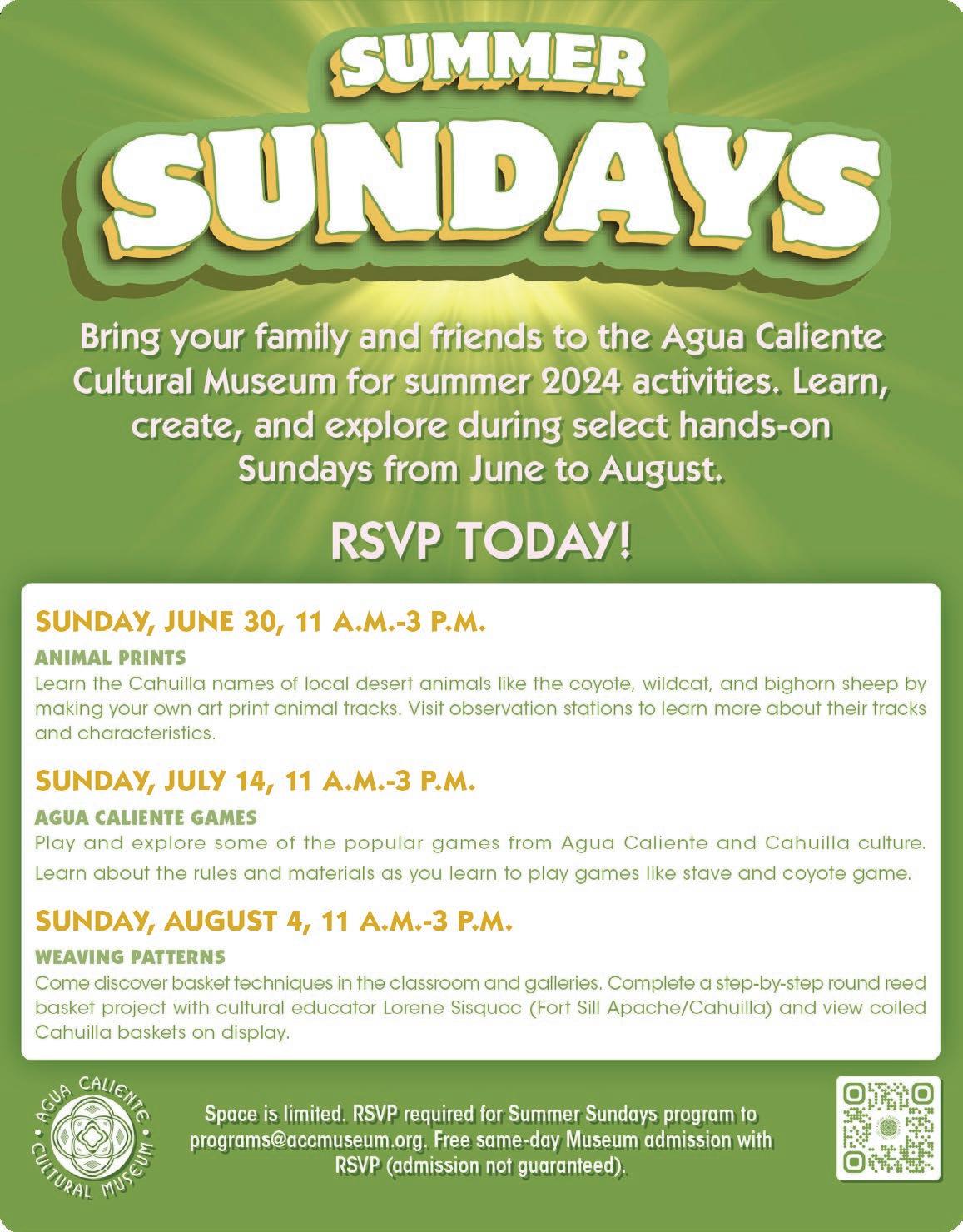


The Trail Keepers
The
Agua Caliente Band
of Cahuilla Indians maintains the many trails of the Indian Canyons (and beyond) for vital purposes, as the Cahuilla people have since time immemorial.
By Susan Myrland
“THE DEEPER the trail, the more it’s been used,” says Tribal Ranger Wade Stevenson as he navigates the gentle but steady incline of Andreas Canyon. Another clue is the color of the sand. It turns dark along ancient passages, the residue from thousands of years of campfires.
The well-worn routes threading the Indian Canyons didn’t appear overnight. They were chosen, built, and maintained, persisting through time, signifiers of the social fabric of the Cahuilla people.
“Every trail led to water,” he continues. “You have to have water to survive out here.” An overnight camp or village would be established away from any danger of flooding, and leading to more trails used for hunting, gathering, trade, or visiting family. Palm Canyon was the Cahuilla people’s Interstate 10, linking to pathways connecting people from the Colorado River to the Los Angeles Basin. As recently as the early 1900s, multiple families would travel up Palm Canyon every October to gather nuts near Pinyon Flats, almost 15 miles away.
Provisions
Modern-day travelers expect to find grocery stores and gas stations along their route. Indigenous trails offered provisions, too, but an effort was required to secure them. Sycamore and cottonwood trees were lightweight enough to transform into bowls, utensils, and portable mortars. The yellow-flowering brittlebush — pá’ akal in the Cahuilla language — acted as an anesthetic. Mothers calmed teething babies by rubbing the sap on their gums. In summer, honey mesquite and screwbean mesquite pods offered a tasty, high-protein snack. Mesquite thorns
were collected for sewing and tattoos, and the dense wood carved into bows and sticks for hunting. Fourwing saltbush made for a nice lathery soap, while the anti-inflammatory properties of creosote bush soothed sore muscles after a long trek. These plants and others continue to thrive alongside the Indian Canyons trails.
Design and Maintenance, Then and Now “All trails were built with function and purpose,” Stevenson says. “The Cahuilla were very aware that going up the side of a mountain was going to wear them out a lot quicker than switchbacking. They were engineers in their own right long before they had any sort of European contact.” Intrepid hikers tackling the West Fork Trail will appreciate those switchbacks as they ascend to 2,600 feet, perhaps spotting signs of old villages along the way. The trail was an important route for the ancestors of the Agua Caliente Cahuilla, who lived in the Indian Canyons, to interact with the Mountain Cahuilla at higher elevations.
Today, Stevenson and other Tribal rangers patrol and maintain 60 miles of trails such as West Fork, keeping them in pristine condition. Trails must be graded at a slight angle to allow drainage, and stable enough for hikers. A key feature, unnoticed by most people, is a “water bar,” an elegant system of flat rocks or wood beams, trenches, and sand. Water bars redirect rainfall to prevent undermining the trail, while adding traction and gradation.
Rangers perform trail work primarily between July and October and maintain the trails daily, year-round. To reduce fire risk, they regularly clear underbrush
and haul it out in 5-gallon buckets and burlap sacks. The Indian Canyons haven’t experienced fire since the devastating Dry Falls Fire in 1980 that tore through more than 28,000 acres and blackened native palm trees along the trails.
Stevenson points out that the ancient Cahuilla carried out the same tasks with hand axes made of obsidian and rhyolite found around the Salton Sea. “Their job would’ve been 10-times harder than ours, but they did absolutely fine with it, and they were consistent,” he says. “That’s why these trails are still around after millennia. They would repair them as soon as they were washed out.”
Respect the Land
Fortunately, most visitors know the Indian Canyons are private, sovereign land, the ancestral home of the Agua Caliente people, not a public county, state, or national park.
Stevenson draws a comparison between irreplaceable pictographs and petroglyphs in the Indian Canyons, and someone’s mementos in their home. “You wouldn’t go into somebody’s house and alter their photo albums,” he says. “You wouldn’t go in their back yard and change the plants. This is the same thing. It all comes down to respect for the land.”
This article originally appeared in the Spring/ Summer 2024 edition of Me Yah Whae magazine, the official magazine of the Agua Caliente Band of Cahuilla Indians.
Photography by Ethan Kaminsky
7




JoshuaTreeSaloon
The Desert Hub for All Adventurers Including Post Malone and Morgan Wallen
By Lisa Lynn Morgan
For decades, the Joshua Tree Saloon has stood as a beacon of hospitality in the desert, welcoming weary travelers and locals alike with open arms. It’s more than just a place to grab a bite or enjoy a drink—it’s a living testament to the rich history and rugged beauty of the Mojave.
As Joshua Tree National Park continues to draw visitors from around the world, the Saloon remains a steadfast fixture in the community, preserving a legacy that spans generations. With each passing year, it continues to evolve while staying true to its roots, ensuring that future adventurers will have a place to call home in the heart of the desert.
Smack dab in the heart of Joshua Tree, it’s hard to miss Joshua Tree Saloon. With its weathered, rustic décor,
and quirky vintage art pieces (like a mounted Ronald McDonald head), you’re transported to a vortex where the old wild west meets early Bob Dylan and maybe even a wandering alien or two. While the ambiance might evoke a sense of nostalgia, the menu exceeds all of today’s standards for good eats. Once you put your face into one of their burgers, you’ll agree - the wild west never had it this good.
This iconic establishment embodies the spirit of the desert, offering not only a respite from the blazing sun but also a vibrant hub of community and culture. At the helm is the ship’s captain, Camille Ladanne. Formerly owned and operated by her father, Gerard Ladanne, Camille came into the venue at the age of 21 where her only expectation was to work as a part time cocktail waitress to help pay for her house. Slowly and steadily,
she graduated to other areas of management, eventually stepping into it full time. Her proven leadership allowed her father to claim, “retirement status,” though you still see him there often, always in a supportive role. “He helps my brain a lot,” shared Camille, fondly. “Being inside your own head, isn’t great. I may already have the answer, but he helps me realize it. The Saloon was my father’s vision from the very beginning. It wouldn’t be what it is today without him.”
The saloon has been through a few changes over the years. Camille’s family first opened the saloon in 1985, purchasing “The Boom Boom Room” and its neighboring liquor store. It was originally renamed “Gabby’s,” in honor of Camille’s grandfather before it eventually claimed its identity as Joshua Tree Saloon.
8
Gabriel Ladanne with Post Malone
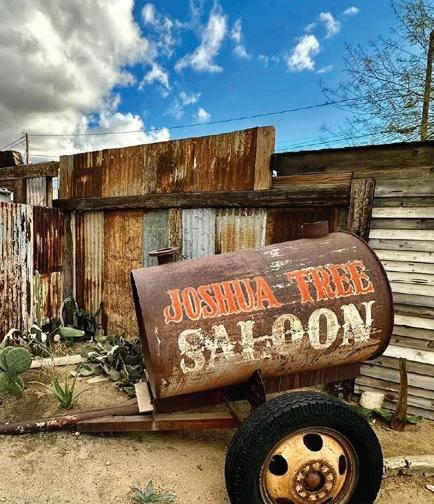
The Saloon’s location and aesthetic make it a popular destination for locals, visitors, passersby, and local military. Often there is a line of folks eager to sit inside. Fortunately, a large patio area in back affords ample seating. But mere popularity doesn’t make a business successful. Camille worked hands on in every aspect of the business in order to pragmatically refine procedures and ensure quality. Her favorite place is in the kitchen, expediting orders and providing hands-on help as needed. No fry goes out cold on her watch.
As challenging as the food industry is, no challenge matched that of the lockdowns that came with Covid-19. Demonstrating a strong ability to pivot, and loyalty to her long-time employees, Camille forged on. For a long time, the restaurant had been dine-in only. But when the only option became outdoor dining, she went to work fine-tuning the back patio to accommodate diners who had very few options to turn to. “I’ve always gone with the flow,” shared Camille, “but I definitely learned
to just roll with things. You kind of just have to learn to bob and weave, I guess,” as she recounted the multiple changes that were thrown at businesses during the crisis. Today, those changes still contribute to the quality and quantity of service to her growing customer base.
Flash forward to 2024 and you have music A-listers seeking out the Saloon for their hit video. Camille recalls not putting a whole lot into the email she received from a producer inquiring about using the Saloon for a video shoot. That email would lead to the Saloon being bought out for none other than Post Malone and Morgan Wallen, who had both just performed at the 2024 Stagecoach Music Festival.
On the morning that the crew arrived, Camille and team came in early after a busy night, to ready the Saloon for the filming (including taking down the iconic Ronald McDonald head due to potential trademark issues). If locals weren’t suspicious that something was going down at the Saloon, the fireworks erupting in the lot out back, confirmed it.

The video and song for, “I Had Some Help,” would immediately go viral upon their release, and while, after editing, you can’t identify the staff, they were all there. The iconic photo of the two hitmakers making heart hands together (seen all over social media), was taken at the iconic sticker wall under the Saloon’s marque.

Even with Hollywood and Nashville in its rear-view mirror, Joshua Tree Saloon remains a place where the community enjoys local stars and live music alongside a full bar and menu that can comfort any pallet. From hearty burgers and savory BBQ to fresh salads, and vegetarian options, good times are a regular tasty adventure. And where many restaurants have been forced to raise prices to accommodate the rising costs of food and labor, Joshua Tree Saloon has chosen to absorb much of that expense making every effort to continue their long history of feeding the high desert as affordably as possible. “You can only raise prices so much,” offered Camille, “and then you just have to accept that you’re going to make less money. There’s a fine balance of staying in business, having quality food, and trying to keep the dishes and drinks affordable.”
No visit to the Joshua Tree Saloon is complete without experiencing its vibrant

entertainment lineup. Throughout the week, the saloon hosts live music performances featuring talented local artists and traveling bands. Whether you’re into rock, blues, or folk, you’re sure to find a toe-tapping rhythm that keeps you coming back for more. And if you’re feeling brave, you can even join in on the fun during open mic nights, showcasing your own musical talents to an enthusiastic audience.
Beyond its culinary delights and live entertainment, the Joshua Tree Saloon serves as a gathering place for adventurers from near and far. It’s where hikers swap stories of conquering rugged trails, climbers recount their triumphs on towering rock faces, and explorers share tips for navigating the vast desert landscape. It’s also a place where locals can share a meal together or sit at the bar and be treated like family.
Here, strangers become friends over shared experiences and a mutual love for the great outdoors. It’s a place where the spirit of adventure is alive and well, fueling the sense of camaraderie that permeates every corner of the saloon.
9
Photos courtesy of Joshua Tree Saloon.
Local Artist, Cory Hamilton, with a gift for Post Malone.
Chris Terres with Post Malone

International Experience, Local Expertise
[Joshua Tree, CA] – Bryan Wynwood, broker/owner of Joshua Tree Modern, has been prominently featured in a recent edition of The Wall Street Journal as an unequivocal and insightful source on the local oneof-a-kind high desert real estate market.
The Wall Street Journal, one of the world’s most respected financial publications, contacted Wynwood for his perspective on what appears for many to be an unexpected drop in market values in the Joshua Tree communities of Yucca Valley, 29 Palms, Landers and Joshua Tree. The article, titled “Joshua Tree Was California’s Hottest Housing Market. What Happened?,” uses Wynwood’s cut-and-dried evaluation of the downfall of unsustainable pandemic housing prices to substantiate the change that much of the real estate community didn’t see coming.
Wynwood is also quoted in the article attesting to his belief that the market will continue to drop in the near term for mid-range priced housing as a result of saturation of local inventory and limited buyer demand due to high interest rates.
The article was published April 3rd, just a few months shy of two years after the Wall Street Journal posted a very different article about the Joshua Tree market on July 3rd, 2022, titled “Joshua Tree, Once Quiet and Quirky, Is California’s Hottest Real-Estate Market” — which also quoted Wynwood, sharing early insights about the market already beginning to slow.
Wynwood’s honor of being a singular and reliable source of local expertise for the Wall Street Journal is the result of his visionary leadership in the high desert community. As broker of Joshua Tree Modern, he’s amassed an international staff educated at some of the world’s most prestigious universities that continues the agency’s commitment to excellence with entertainment industry experience and multilingual services in Spanish, Portuguese, Vietnamese and more.
JTM is dedicated to leading the real estate market with pragmatism, transparency – and prides itself on servicing clients from first-time buyers to industry titans with the same privacy and down-to-earth attitude.
SELLING JOSHUA TREE REALTY FOR 20-YEARS
For more information please visit https://joshuatreemodern.com/










Hargo Khalsa 505-927-1025 DRE: 02058377 Valerie Drukas 760-835-5198 DRE: 02125291 Karla Ruzicki 310-569-0122 DRE: 02213364 Haley Hefner 321-961-8224 DRE: 02182037 Bryan Wynwood 760-808-4806 DRE: 01448338 Areeya Grace Nedwong 760-974-2125 DRE: 02058377 Ha Huynh 805-558-5310 DRE: 02154966 James Dwyer 760-821-7102 DRE: 02224209 Evan Cuellar 530-440-2192 DRE: 02004590 Courtney Houston 252-245-1902 DRE: 02119114
My Voice
My Voice is a place for individuals to write in and have their voice heard in celebration or concern regarding our hi-desert community. If you would like to submit an editorial, please email info@joshuatreevoice.com.
Proposed Budget Includes a 58% Cut to Existing Arts Programs
Hello friends,
As some of you may know, the proposed 2024-2025 California State Budget includes a $10M cut to California Arts Council funding for small arts nonprofits, and the elimination of the $12.5M Performing Arts Equitable Payroll Fund, among other budget cuts. These cuts represent a disproportionate 58% cut to arts programs.


https://secure.everyaction.com/jDPLaTbm-0C59oel6RQxRQ2


A message from CA Arts Advocates:
• Urge Your Representatives To Oppose The 58% Cut To CA Arts Spending
• Joint Call to Action from CA Arts Advocates, Actors Equity, and Theatre Producers of Southern California
• Send a letter to the Governor and your State Assembly Member and State Senator, urging them to oppose these measures and restore the modest funding. You can customize your message to let them know how state arts funding impacts your practice, livelihood or community.
Thank you for all you do to keep arts and culture thriving in the Morongo Basin. With gratitude (and a little “get it” attitude),
Marie Bobin
Arts & Culture Management Consultant
Portfolio www.mariebobin.com Email mariebobin@gmail.com
11
June’s Hi Desert ART ROUNDUP
By Katie Nartonis
29 Palms Art Gallery
Twenty-Nine Palms
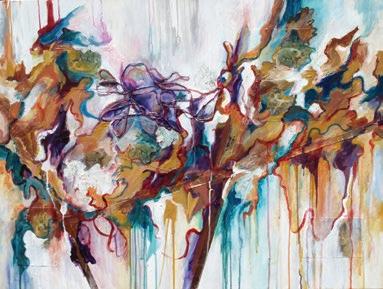
Joan Scott: The Adventures of Being an Artist
“The desert is an exciting place with rocks, mountains, creatures, and plants of many shapes, sizes and colors! Looking out the window or walking along a trail or road, I pause and focus on the many patterns, shadows, shapes, and textures - here, there, and across the valley.” – Joan Scott
Joan Scott, a Yucca Valley resident and long-time member of the 29 Palms Artist’s Guild, presents her solo show: The Adventures of Being an Artist. Unlike many artists, Scott says she has never specialized in just one technique. The artist notes, “With these pieces, I would like to lay out a visual story line showing how adventures over the years, the many places I have visited and the artists I admired and worked with, have influenced my work. I am pleased to have this opportunity to share this at the 29 Palms Art Gallery.” Scott has truly enjoyed exploring and sharing art in its many forms. Some of her work is realistic, but also includes mixed media and abstract images. She relates, “I have truly enjoyed exploring and sharing art in its many forms and approaches!” This show is about her adventures as a woman who embraces new experiences, various cultures, and how she lives life with an open mind to life and people, which are all inspiration that leads to another artwork creation. She continues, “My passion for art in many forms is still evident, even as I lose energy and forget
things! I’m delighted at the incredible variety of themes. materials, colors, and techniques that the many local artists keep displaying throughout this special desert area!! Go! Paint! Build! Teach! Enjoy sharing your creativity! I have, and I happily pass on to all the many adventures of being an artist!”
Mark Spicak is a master of desert landscapes in oil and acrylic. His realistic approach captures the light, and the fauna and flora of the desert southwest in a way that makes the viewer feel as if they are a part of the scene. The artist has donated many of his original works on canvas to the Twentynine Palms Art Gallery. He now lives in Rancho Mirage and continues to paint and create new work. For the first time, these early works will be shared with the public in an exhibition. Mark is a hiker who enjoys being out in nature and paints landscapes from points of view not often seen by the average individual. His perspective gives the viewer a glimpse into our beautiful and fragile planet.
Show Dates: May 31 – June 30
Opening on Saturday, June 1: 4-6pm Gallery is open: Friday – Sunday, 11am – 3pm 29 Palms Art Gallery, 74055 Cottonwood Drive, 29 Palms, CA 92277
Photo: Mark Spicak

La Matadora Joshua Tree
“Viva La Luchadora!” A group show with featured art by Martín Quintanilla from Pátzcuaro, Mexico and also showing - DEFILED: Part 7 (thrifted altered art). The art is on view through July 7, 2024. Three bands will play the opening during the reception on June 8, 6-9pm: The Websites (from Tucson), Bug Club (from Tucson) and The Hula Hoes (from Morongo Valley).
La Matadora Gallery is located at 61857 Highway 62 in Joshua Tree. Gallery hours: 12-5 PM Sat/Sun & by appointment. For more information, contact Colleena lamatadoragallery@gmail.com or IG: la.matadora.gallery
La Lucha by Martìn Quintanilla

12
Photo:
HeyThere Projects!
Joshua Tree

HeyThere Projects! will feature the work of Melissa Monroe and Adam Shrewsbury through June 6th. The June show features artist Kevin Snipes. At the time this article went to press, HeyThere wasn’t sure what works Snipes would create for the show. So, go to the show and be surprised!
Figure Drawing at HeyThere Projects Hooray for HeyThere’s recurring life drawing sessions the first Thursday of each month! Featuring a full 3 hours of multi-poses from 5 to 45 minutes in duration. The first part of the drawing club will start with classic figure poses and build to longer poses with costumes. Theme nights and great music set the tone! The gallery will supply chairs, tables, and some drawing boards for participants, but they ask guests to bring their own paper and drawing materials. They also have supplies available in the store for purchase if needed. Free refreshments will be available to participants as well. Hosted by Ben Vitale. First Thursday of each month, -8pm. $25. For more information, https://heythereprojects.shop/products/ desert-draw-club
Location: 61675 Twentynine Palms Highway, Unit 2, Joshua Tree, Ca 92252 heythereprojects.com and @heythere_projects
Image: Kevin Snopes


Opening mid-June, the Hi-Desert Artists first show, the “Inaugural Members Exhibition”, opens to coincide with the larger Yucca Valley Art walk. An amazing 74 local desert artists are included in this show with a wide variety of painting, sculpture, and mixed media. The Feature Gallery will include a show of paintings by the uber-talented painter, Paul Donaldson.
The renovation of the Hi-Desert Artists center is nearly completed, and visitors will notice a new exterior as well as interior changes to accommodate the gallery transformation. A Steve Reiman sculpture has been donated for the front yard, and the space inside will be ready for a continual stream of exhibitions throughout 2024, including the MBCAC Art Tours Collective Show in October! In addition to the galleries, the Hi-Desert Artist’s Gallery Shop will have a great selection of high-end crafts by local makers. The opening celebration will feature music by Blues Oasis. We can’t wait to celebrate this beautiful manifestation of our local art community, kudos to the artist members who made this happen!
For more information: www.hi-desertartists.com and info@hi-desertartists.com
Space Truckin’ Gallery
Yucca Valley

“Put a Joshua Tree On It!” show. This eagerly anticipated annual themed show opens Saturday, June 3rd.
Reception from 5-8pm. Enjoy Joshua Tree art, prizes, hot dogs, and refreshments.
Address: 55940 29 Palms Hwy suite 2, Yucca Valley, CA 92284
Photo: Put a Joshua Tree On It!
THE SPAGHETTI WESTERN SALOON SALON: “WITH WATER” ART SHOW THRU JUNE 23
By now most High Desert residents and visitors have eaten at (or at least heard of) Spaghetti Western Saloon. In its first year it’s become known as a premier eatery, as well as a fabulous music venue in the Morongo Basin. What some have been missing is that, along with dining and live music, one can also see the work of iconic desert artists in Spaghetti Western’s “Saloon Salon.” The Salon is an intriguing gallery space that has new exhibits every two months. So far there have been eight shows featuring eleven artists, working in a variety of media ranging from paintings and photographs to rust and nails.
Timothy Hearsum has been a hi-desert resident since 2015. This is the first exhibition featuring his watercolors. His photographic work is known internationally through numerous exhibits, public, private and corporate collections and Getty Images. He has also published several books. Exhibiting along with Hearsum is artist Joanna Fodczuk-Garcia Originally from Poland, Fodczuk has exhibited extensively in the U.S., Poland, Germany, Mexico, and South Korea and has lived in the hi-desert since 2014. A fierce abstract painter in oil, acrylic, and watercolor, Fodczuk explores shape, light, and color with a raw abandon. Her art reflects a deep connection with the arid magic of the hi-desert landscape. Both artists rely on the delicate usage of water in their process, allowing water and paint to reveal the terrain of their work. They bear witness to their art as it happens, interrupting as little as possible.
“With Water” runs through June 23 and can be viewed anytime during regular restaurant hours (Thursdays-Sundays 11 a.m. - 10 p.m.) Come for the art, stay for dinner and music, all at Spaghetti Western Saloon.
Western Saloon is located at 50048 29 Palms Highway, Morongo Valley.

Katie Nartonis is a writer, curator, film maker, and specialist in art and design. Her current exhibition (and documentary film) opened during 2024 Palm Springs Modernism Week: “Jack Rogers Hopkins: California Design Maverick” and is open through September 28th at the historic Sam Maloof Foundation. Look for her upcoming book, “Glimpses of the Joshua Tree Dream.”
13
Hi Desert Artists Center Yucca Valley
Photos:
Cybele Rowe, Ceramic sculpture for Inaugural Members Exhibition at Hi-Desert Artists Gallery
Esther Shaw, painting for Inaugural Members Exhibition at Hi-Desert Artists Gallery
Spaghetti
The Desert Split Open Celebrates Hi-Desert Pride
Sunday June 23, 2024, 12:00-5:00 PM Beatnik Lounge: 61597 29 Palms Hwy, Joshua Tree, CA
By Lady Chilane
Join us for a day of LGBTQ+ Pride. The Beatnik opens at 12:00 noon for those wanting to catch the special “Queerated” community art show. Enjoy light refreshments and browse books and art for sale from our featured artists.
At 1:00, we begin with remarks from our special guest, Flint, a trans and queer education human rights content creator with 350,000+ followers on both Instagram and TikTok. Flint and his partner recently moved to the Hi-Desert from Orange County, where Flint was an openly trans public-school teacher. For almost 8 years, he hosted a popular, 200-title LGBTQ+ library, curated by students, until he became the focus of national far-right media attacks and constant public threats.
At 1:30, three featured readers, Barb Morrison, Ruth Nolan, and Susan Rukeyser will share brief excerpts from their work, as they did as panelists on “Queering the Literary Landscape” at this year’s Bombay Beach Lit Fest.
Barb Morrison is a top 5 Billboard dance chart songwriter and platinum record producer best known as producer for artists such as Blondie, Rufus Wainwright, and Franz Ferdinand, and as an ASCAP featured film score composer. They just released their first book, bottoming for god
Ruth Nolan, a former wildland firefighter, writes about life in the non-binary
Mojave Desert, where she’s lived for most of her life since childhood. Her books include After the Dome Fire and No Place for a Puritan: The Literature of California’s Deserts (editor).
Susan Rukeyser is a writer and host of Joshua Tree’s “feminist, queer, and otherwise radical” Desert Split Open Mic. Her second novel, The Worst Kind of Girl, is out this June. Set in Yucca Valley and Joshua Tree, the main character comes out at 50 years old.
At 2:00, it’s time for the Open Mic! Everyone is welcome and encouraged to read LGBTQ+ poetry or prose – any form, any genre, their own or someone else’s –for up to 6 minutes.
At 3:30, to close out the show on the right, sparkly note, we will enjoy a brief performance by special guest, (ME!!!)
Lady Chilane. A drag performer, originally from Tennessee, who now resides in Joshua Tree, Lady Chilane hosts a variety of shows across the Hi-Desert, including Drag Bingo, and recently filmed a movie due to be released later this year.
Questions/Contact: Susan Rukeyser, desertsplitopen@gmail.com | Instagram: @desertsplitopen
Based in Joshua Tree, California, the Desert Split Open encourages and amplifies literary work that is feminist, queer, or otherwise radical.

14

Queer Love Blooms in the Desert: The Worst Kind of Girl
by Jennifer Lewis
In Susan Rukeyser’s second novel, The Worst Kind of Girl, published in June by Braddock Avenue Books, 50-yearold Paula Winger moves from Connecticut to Joshua Tree after her husband mysteriously disappears. Seeking a fresh start, Paula takes over the Hi-Dez Motel and becomes an aspiring writer. Dead bodies begin to surface in the desert, implicating Paula, and the motel’s relatable bohemian residents as potential suspects. Amidst this mystery, Paula unexpectedly falls in love with a woman, leading her to explore her queer identity later in life.
I sat down with Rukeyser at Más o Menos where we discussed how the desert influences her writing and her exceptional ability to create characters who challenge stereotypes related to aging, desirability, and sexuality. She shared insights into her parallels with Paula, who, like Rukeyser, is a prominent figure in Joshua Tree’s queer community. Rukeyser hosts the Desert Split Open Mic at the Beatnik Lounge, a platform that amplifies feminist, queer, and radical voices. The next event, celebrating HiDesert Pride, will be held on Sunday, June 23rd from 12 pm to 5pm.
JTV: How did you approach making the desert an integral part of your novel?
Rukeyser: The desert is what made writing this book possible. It was the first place that felt like home to me. Prior to living here, I was a writer who was trying to come to terms with the fact that my work wasn’t going to be rooted in place, because I didn’t have a home. But once I moved to Joshua Tree, I felt very much rooted in this place, its clarity, quiet, and space. I could finally hear myself think. I had just turned 50, so I was taking stock of things. The desert is a fascinating setting to me because it will kill you. It is looking for a reason to kill you, honestly. I love this place. I love the people who find their way here because we’re all looking for something. We’ve fallen in love with this place because it makes us feel something. It makes us feel capable of pursuing our dreams a little bit more freely.
JTV: In which ways do you relate to the main character Paula Winger?
Rukeyser: Paula has similar traits to me. She’s tall. She has gray hair. She’s from Connecticut. We both fell in love with a woman after a lifetime defined by relationships with men in a heteronormative society. That was a huge change for me, and I wanted to explore that evolution through my writing. I had her explore some of the same things, then I sent her off into her own story that had nothing to do with me. With our fictional characters, we can let them have a little bit more freedom than we give ourselves.
JTV: Paula really challenges stereotypes about aging, desirability, and sexuality. Do you feel a responsibility to create a character like Paula in order to break these taboos, or do you go about your writing by telling stories that are important to you?
Rukeyser: It was very important to me, not just from a feminist perspective, but from my personal experience.

Society desexualizes women as soon as they have a kid. I did my time in the suburbs as a mom. I remember thinking these people have taken on a PG-rated life just because they’re parents. And it was very strange to me because I was like, there’s only one thing that got us all here with kids in the first place.
I wanted to show what I see as perfectly normal when you actually talk to women, which is that they never stop being interested in sex. And maybe even more so as they get older and realize what they like, and they don’t have to worry about getting pregnant, which is a not insignificant thing, especially right now.
We sort of desexualize women when they become mothers, but we certainly do by the time they get anywhere near menopause, and there’s still decades and decades left of potential sex. I wanted to show that Paula is not above having sex without love. If love’s not around, well, that’s not going to stop her from having sex. I hope that [my novel] helps open people’s minds and stop folks worrying so much about what’s respectable for them to be doing at 50.
JTV: Your supporting characters capture Joshua Tree’s vibrant bohemian community. Did you write about real people? Or was it completely from your imagination?
Rukeyser: All the other characters are completely fictional. But they are also composites of myself, everyone I ever met, or stared at, or listened to. In fact, I’ve been listening to these characters talk to me since 2012. I let them tell me who they are and what they look like. As far as portraying the community, I wanted to be very authentic, respectful, and truthful without glamorizing or making caricatures. Because those are two things that the desert is subjected to on a regular basis. And there are real people living here, and they’re much more interesting than caricatures.
JTV: Even though your novel is character-driven, it also has a lot of plot twists–including a dead body that turns
up in the desert. What was the inspiration there?
Rukeyser: I knew I wanted to write about bodies and absence. The literal absence of a body, as well as how we can pull away from each other and be gone, even while in the same room. I can’t remember which body it was, but there was a body on fire in the news. I hadn’t lived here that long, and I thought, there are bodies turning up here all the time, sometimes on fire.
JTV: When Paula is so unconcerned about being considered a suspect, it actually made the book more tense for me. Was that intentional?
Rukeyser: I didn’t do that on purpose, but with this book, I decided not to worry about writing rules or rules of any kind. I trusted my instincts. I knew Paula, like many women, is used to being treated with suspicion, and she is distracted by the major shifts happening in her life. I wanted the questions others had for her to take a backseat to her own exploration of identity and joy.
JTV: Is the idea of “gas station sushi” based on something real, or is it just a humorous invention?
Rukeyser: As far as I know, there is not a gas station in the Morongo Basin that sells great sushi, but there was a good sushi restaurant in that Travelodge Inn and Suites at the far west end of Yucca. Their sign was actually the inspiration for the book’s cover.
JTV: Paula’s advice throughout the book reminded me of the empathetic guidance found in Cheryl Strayed’s “Dear Sugar” column. Sayings like, “You get to write and rewrite your story infinite times and always be the star. Don’t edit yourself to silence.” Did you feel like you were passing on some wisdom?
Rukeyser: When you hit 50, you stop caring quite so much about what people think of you, and you realize even if I don’t think of myself as a wise person, I’ve picked up some stuff along the way.
JTV: Over the course of the book, Paula becomes a prominent figure in the queer community. What kind of impact do you hope her character will have on the readers?
Rukeyser: Paula would giggle at that and probably say, “Oh, I’m not a major figure in the queer community,” because she was coming into her queerness later in life, I don’t know that she was fully owning it, yet. When you’re coming out as late as I did, it’s like an identity crisis. The sexuality part might be easy, but you have 50 years of being straight. You’ve got everything that you ever said about yourself stored in your head. And now you have to adjust the narrative. This book is for the people who think it’s too late to make major changes. That’s nonsense. It’s never too late. The only thing that was holding Paula back from being accepted was herself.
Jennifer Lewis is a writer, editor, and publisher of Red Light Lit.
15
Photo by Sandra Goodin

Jacobine van der Meer: Amsterdam to Landers
I was lucky to have parents who took me, from an early age on, to many culturally rich places in Europe where I was able to absorb art from a variety of periods. I now realize how important this has been to my development as an artist.
Jacobine
-
By Katie Nartonis.
In an exclusive interview with the Joshua Tree Voice, HiDesert artist Jacobine van der Meer described her early life growing up in Amsterdam, The Netherlands. She relates, “my life began in a multi-generational household in a canal house in Amsterdam. The house was owned by the protestant church of which my grandfather was a pastor.” From the 17th through the 19th century, Van Der Meer notes that canal houses were built to store goods acquired through overseas trade and colonization. “Part warehouse, part residence, they were connected to the larger waterways on which ships brought in spices and other goods from as far as Asia, Southern Africa and the Americas” She continues, “During the ‘Golden Age’, it was a time in which The Netherlands dominated overseas trade, including the Atlantic slave trade, the middle class was able to acquire a substantial amount of wealth and Dutch culture flourished.”
Proof of this controversial past is still visible in some of Amsterdam’s architecture as well as in its historical museums of which the Rijksmuseum is the most wellknown. “I have visited the museum since childhood and it is like the ultimate treasure chest. My favorite section is a fascinating collection of Dutch paintings from the Middle Ages. I have always been drawn to their vibrant, colorful narrative religious scenes full of symbolism, and
van der Meer

their radiant depictions of natural phenomena. They are like an alternate universe full of costumed fantastical characters in which one can get lost. I still visit them when I can.”
After high school and a 3-month stint at university studying psychology, Jacobine studied painting at The Academy of Fine Arts in Amsterdam. She dropped out after 3 years. She lived through a solitary period, “painting in a dark cellar studio with only one tiny window, made me realize that I was not ready to be a full-time painter and needed to do some exploration. While working odd jobs I did just that.” She continued, “It was a great time to be in Amsterdam in my twenties, the city was full of creativity and DIY spirit, there were inspiring art shows and concerts in the squats and other independent places. With a group of friends, I regularly binge-watched a plethora of horror and absurd movies and this sparked my interest in special effects (SFX) make up and character development. I learned how to sculpt, mold, cast and paint prosthetic appliances, bodies and body parts and started working for Dutch television and film, physically transforming actors into their characters and sometimes simulating gory situations. I also worked on multiple projects for museums, making hyperrealistic human figures.”
16
Installation view Queen Clone, Joshua Treenial, 2023.
Photo courtesy of the artist.
Installation view ANA 1, La Casa Erosionada, 2023.
Photo by Nicole Valenzuela.
Intrigued by Hollywood’s special effects industry van der Meer moved to LA in 1998 and started working for special effects companies, mainly as a sculptor. “It was a great opportunity to focus and to fine tune my skills. I became involved in film projects by the artists Dough Aitken (Blow Debris) and Matthew Barney (Cremaster 3). These multi-disciplinary projects were much more interesting to me than the commercial projects that I mostly worked on and they brought me back to art. At that time LA artist Paul McCarthy was setting up a movie studio and SFX shop for his film Caribbean Pirates and hired me as a sculptor. I fell in love with one of the pirates, actor/ filmmaker/ artist Emmy Collins, it was mutual and we are still together! I worked at McCarthy’s continuously expanding studio for the next 17 years, as head of the sculpture department and eventually as part-time sculptor, while slowly building up and exhibiting my own body of work.” In 2004, she set up her studio in Landers where she had bought property. In 2019, she moved to live and work full-time here in the desert.
Besides the movie industry, there were other reasons that drew her to the United States and eventually the desert. Most important has been a feeling of openness and vastness in space. “The Netherlands is a country in which humans have altered most of the natural world. As a small and very densely populated country, every area is used with a purpose. When I first visited the Morongo Basin in 1996 something clicked right away. The Joshua Trees and other flora which look like characters, in their sandy settings bordered by mountain ranges and illuminated by an ever-changing sky made me feel like I was in the right place.”
The artist thrives in this environment. “I am extremely lucky to live in a sparsely populated area. The house has big windows which make me feel connected to the outside. I walk every day. Each day is different, each year is different. The longer I live here - the more I see and learn about the animals, the underground world in which they survive during extreme temperatures, and the cycles of the plants and their ways of adjustment. I have gained a deeper respect for the natural world.” She relates that “In the city I felt like I had to build up a ‘wall’ to limit an overload of stimuli. In the desert I don’t need this wall and I can let the outside in and the inside out. Reverence for the natural world becomes a certain spirituality. My work became affected by this and I started to see some connections between my work and art from cultures that live or have lived in close contact with nature. It is an ongoing process.
A few of my works have interacted with the land. ‘Black Clay’ (2018) was a short film and installation in which the performing characters were monumental forms sculpted from the fertile clay that came down from the mountains after a flash flood. It tells a cyclical story of life and death. A sculpture and sound installation ‘Head Space’ (2019, Mojave Sound Art, ‘Incantations’) for which the audience was invited to listen to recordings of my voice mixed with sounds of desert animals. All while looking through mask-like animal head sculptures towards a focal point after which they were invited to project their own voice into the land. Finally, ‘Queen Clone’ (1st iteration) (2023, Boxo PROJECTS, Joshua Treenial, ‘Aterritorial) A sculptural installation inspired by King Clone, the 11,700 year old creosote ring in

Johnson Valley. It is one of the oldest living organisms on earth. The piece is focused on the organism’s ability to reproduce asexually by means of producing clones. The work consists of a negative mold of a large sculpture named ‘The Original Ancestor’ and two casts out of this mold, “The Clones”. The project is continuing. Extreme winds are altering it and make me respond. It is exciting for me to keep certain projects active and let them be in dialogue with their environment.
In a surprising development, Van Der Meer was invited (through Instagram) to participate in group exhibitions in Mexico - on two separate occasions. The drawing exhibition “Operadores de Mutación at Espacio Cabeza/ Materia de Dibujo in Guadalajara (2022) and the exhibition ‘La Casa Erosionada’ at the Anahuacalli Museum in Mexico City (2023). This museum was built by famed Mexican muralist and painter Diego Rivera, and houses his extensive Pre-Columbian collection of mainly sculptural art. Build from local black volcanic stone, it is like a temple and contains many layers of information and meaning. The contemporary exhibitions interact with the building and the historical sculptures which are like a big family of characters with many stories to tell. It also has a large ecological space with protected endemic flora and fauna. Along with showing drawings there, I made and showed a small sculpture called ANA1, inspired by the museum. “She stayed there and I imagine her talking to the Pre-Columbian characters. To be invited into this fascinating country in which I had never been before was a humbling, meaningful and also very exciting experience. Being at the Anahuacalli and a visit to the Museo Nacional De Antropología, which was sculpture heaven to me, were profound experiences. I am now learning Spanish and hope to return.”
As an artist Van Der Meer wants to keep ‘playing’, and she does not care about fitting into a certain part of the art world. For the last 3 years she has been working as a teaching artist with kids at public elementary
schools here in the desert through an initiative called Groundwork Arts. “I learn as much from them (the kids) as they from me. Especially for the youngest ones, creativity is natural and we are working with all the students to keep that creativity accessible and help them use it as an outlet which hopefully benefits them in the future.”
She is currently working on a series of drawings and sculptures depicting female characters with animalistic elements like fangs and claws. Their bodies are like internal environments and express womanhood including the often uncomfortable and painful natural bodily processes we experience. “They are fighters. The restriction of abortion in this country has infuriated me and I need to respond.”
My artwork can be a drawing, a sculpture, a large installation or a sound performance, it is all related and feeds of each other. It usually involves creating characters and a narrative. My sound performances are always done in costume, I am a moving and sounding sculpture. I mostly use my voice and manipulate it through effects, it is emotional, direct and intuitive, even cathartic. I often perform as ‘The Brutal Poodle’. For the Queen Clone project, I embodied the ‘Original Ancestor’ and did a vocal performance from within the installation in a costume made from discarded mylar balloons which I found stuck in the creosote bushes on my walks.
Central in her work is the examination of the juxtaposition of the artificial and the natural, and she sees it as one the biggest issues of our time. “My works contains organic and geometric shapes, natural and artificial materials, the voice manipulation is through electronics. My work method is like a back-andforth rhythm of letting go and regaining control. This dichotomy of being part of a society tethered to ever more complicated technology while also being part of a natural environment affects me deeply. Luckily. I do have this outlet and by communicating through art I hope to give something back somehow.”
She acknowledges that there is a part of our desert community which is very active in protecting the desert’s fragile ecosystem - and there have been many successes. Her hopes are for a continuation and expansion of this as well as for a growing awareness that we have taken and are still taking too much. “It is time to give back. Otherwise, our community is going to face a much more difficult future and I would hate for that to happen, especially to all our young community members. I hope natural balance will be restored.”
For more info: Instagram @jacobinevandermeer

17
Queen Clone performance at Joshua Treenial, 2023. Photo by Emmy Collins.
Katie Nartonis is a writer, curator, film maker, and specialist in art and design. Her current exhibition (and documentary film) opened during 2024 Palm Springs Modernism Week: “Jack Rogers Hopkins: California Design Maverick” and is open through September 28th at the historic Sam Maloof Foundation. Look for her upcoming book, “Glimpses of the Joshua Tree Dream.”
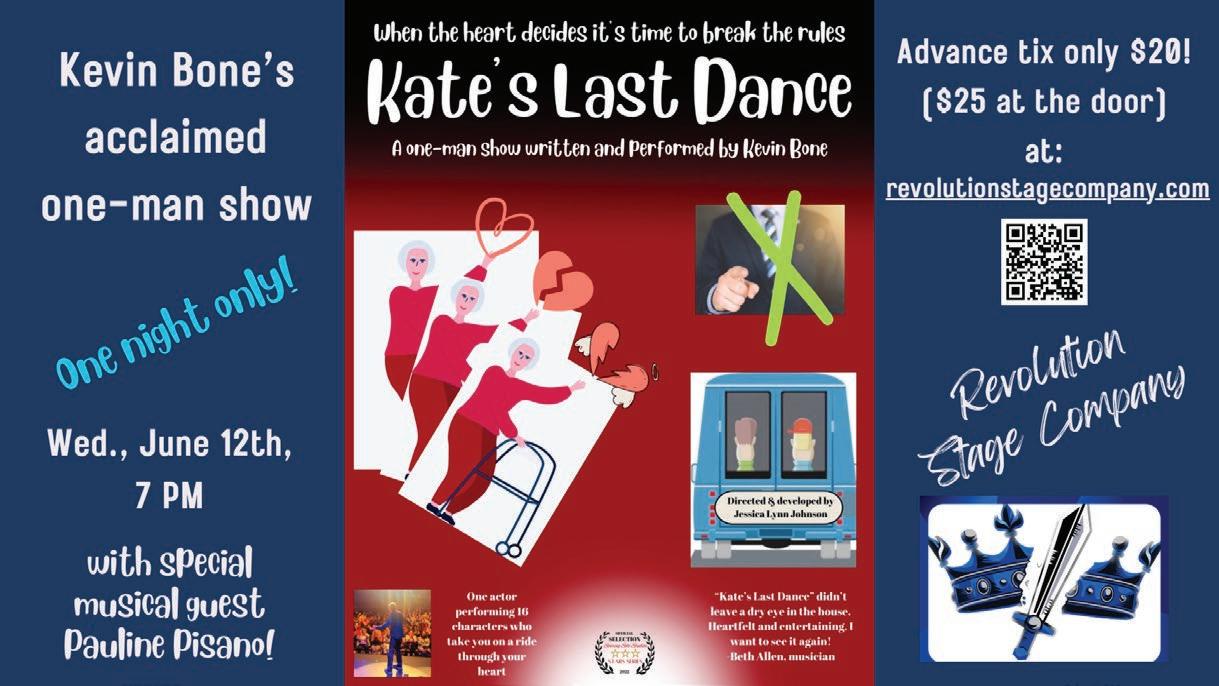






BRANDING WEB DESIGN SEO SOCIAL MEDIA ADVERTISING POINTED SERVICES WEB DESIGN & DIGITAL MARKETING pointedservices.com 760.396.8029 STAY IN YOUR LANE.
FIRE AND FLIGHT RETREAT
Are you ready to break free from the zoom calls, get up out of your chair and start experiencing life again?
Come join us for three days in the California desert, playing with fire and learning to fly! Fire and Flight returns to Twentynine Palms, Sept 26th-28th 2024. Maybe you’re a performer who misses the freedom of performing on stage, maybe you’re an experiencejunkie who’s bored of staring at the same four walls. Maybe you’ve just realized that life is too short and it’s time to shake things up.
Get your body moving again, connect with likeminded people and find a whole new way to express yourself through fire and aerial performance. After these three days you’ll leave feeling uplifted, empowered and regenerated – like a phoenix from the ashes ready to take on your next chapter.
THIS IS AN EXCLUSIVE EVENT LIMITED TO A MAXIMUM OF 18 PARTICIPANTS
Award-winning international variety performance artist and coach, “Vixen DeVille” (aka Cat LaCohie), joins forces with Cirque du Soleil aerialist, and founder of aerial acrobatics training school, Grounded In Flight, Amanda Ritchie. Together they will guide you through a transformational weekend of creative self-expression using aerial and fire performance techniques.
This unique retreat experience is designed to help build mental and physical strength, increase selfconfidence and to give you a much needed ‘time-out’ by stepping into our world of safe and supportive creative exploration.
Now is the time to spread your wings and take flight.
With only 5 spots available you can find info and sign up at www.FireandFlight.com or be added to the waiting list either for Sept 2024 or for March 2025 by emailing Vixen@VixenDeVille.com.





Thursday Sept 26th –Saturday Sept 28th 2024
19
Photos Courtesy of Fire and Flight

Where Big Music Finds Its Home in the Desert Gatos Trail Recording Studio
By Lisa Lynn Morgan
Nestled within the captivating expanse of the Mojave desert landscape, Gatos Trail Recording Studio stands as a testament to the fusion of rustic charm and cutting-edge musical innovation. Housed in a cozy 1,200 square foot barn, this studio offers more than just a space for recording—it provides an immersive experience marinated in Mojave vibes.
The studio’s interior boasts huge windows that frame breathtaking views of the arid landscape, creating an inspiring backdrop for creativity to flourish. With a live room, control room, two isolation booths, and an impressive array of vintage and modern gear— including a 24-track 2” tape machine—Gatos Trail offers everything artists need to bring their musical visions to life.
At the helm is Daniel Joeright, a seasoned musician and engineer. “I’ve been playing the drums since I was 5,” shared Joeright, “following in the footsteps of my dad, who was a drummer back in the day.” Joeright went on to study at Berklee College of Music and has performed with a diverse range of bands and artists over the years, including The Rentals, Terry Hall, Sasquatch, El Vez, and Jim White, among many others. “Currently, I play in and produce my own musical collective, Earth Moon Earth, which features an eclectic lineup, including vocalist Skye Edwards from Morcheeba and 29 Palms resident Rich Good (guitar) from the Psychedelic Furs. Recently, I teamed up with guitarist Gary Arce of Yawning Man and Norwegian vocalist/bassist Pia Isa to form a new band called SoftSun. Our debut album is set to be released on Ripple Music later this year.”
Gatos Trail’s allure lies in many things but most uniquely, the commitment to capturing exceptional live drum sounds. Joeright has meticulously designed the live room to accentuate the warmth and resonance of each beat.
“Being a drummer,” shared Joeright, “I naturally designed the live room with a focus on drum sounds. To that end, I incorporated lots of reclaimed barn wood interspersed with absorption materials which, together, add a live warm tone without any unwanted sound reflection. I also spend a lot of time experimenting with tuning and micing techniques, paired with different preamps, eq and compression, on different drum kitsmany of them available for sessions here. I always have my preferred drum sound ready to go, but if a session
20
Dan Joeright & Chris Goss, Gatos Trail Control Room.
Photo © Hannah Malott
comes in with a different sound in mind, we can easily achieve it.”
In addition, Joeright brought in former Drum Doctor tech, Aaron Farinelli, as a second engineer. “He’s a great asset,” boasts Joeright. “While working for Drum Doctors in Glendale, Aaron would get called in for recording sessions with legendary artists like Paul McCartney and Jim Keltner to make sure the drums were tuned correctly, and everything was sounding just right. We definitely have fun dialing in the drums here, and it shows. I was honored by the compliment given to us by desert rock legend Chris Goss (Masters Of Reality) saying that Gatos Trail had “the best drum room in the desert.”
Lodging is another aspect that draws artists to Los Gatos. The studio’s on-site lodging - a meticulously appointed ranch house and vintage travel trailersprovide a sanctuary for relaxation and inspiration. Guests can unwind in the 8-person hot tub under the stars or gather around the outdoor BBQ grill and fire pit, forging connections and memories that transcend the recording process. “Guests tell me how comfortable it is to walk in and immediately feel the spirit of the desert which inspires calmness and creativity,” Joeright shared. “There are amazing vista views from every corner of the property, and I’ve kept a classic desert feel throughout the hang out areas, living spaces, and the studio itself. I love to host and share this special place with others. I go out of my way to make sure our guests experience the special things that I love about the desert and the Gatos Trail property.”
Over the years, Gatos Trail Recording Studio has played host to a diverse roster of artists, both local and national. From Grammy-nominated sensations like SZA and Sharon Van Etten to indie darlings such as Young The Giant and Twin Shadow, the studio has earned a reputation as a destination for top-tier talent seeking to capture their creative vision.



As a testament to its commitment to fostering community, Gatos Trail hosts an annual Summer Solstice event known as the Yucca Man Shakedown. This festive gathering, set against the backdrop of the studio’s picturesque surroundings, features live music, DJ sets, and delectable cuisine courtesy of local vendors. “It’s a semi-private party, but Joshua Tree Voice readers are welcome. Just don’t tell anyone,” winks Joeright. “The details are still being worked out, but there will be bands, DJ’s, tacos by the fine folks at La Caguama, and other fun stuff.” Yucca Man Shakedown is scheduled for Saturday, June 22 at 5 pm.
Joining the desert’s musical legacy, Gatos Trail Recording Studio stands as a beacon of musical excellence and artistic expression. Whether you’re a seasoned veteran or a burgeoning talent, this vibey desert farmhouse offers an unexpectedly spacey sanctuary where big music finds its home amidst the majesty of the Mojave.
For more information and booking inquiries visit the website: gatostrail.com or email them at gatostrail@gmail.com
Follow them on Instagram: @gatostrail and Facebook at Gatos Trail - Recording Studio
21
Chris Goss & Dan Joeright, Gatos Trail. Photo © Hannah Malott
Mekons at Gatos Trail.
Photo © Dan Joeright
PRIDE EVENTS JUNE 2024
6/1 - 7/15
29 Queer Film Festival Submissions accepted all month! A festival celebrating LGBTQ+ film in Twentynine Palms, California. Organized by @grahamkolbeins and @ jonathanandrethegiant
IG @29queerfilm Submissions: forms.gle/tGQmPNdd2a2oxCWj6
Tues 6/4 @ 6 pm, reservations required Cabaret La Copine
C’est Claire w/the iconic drag queens of the Haus of Derma La Copine
848 Old Woman Springs Road, Yucca Valley, CA 92282 IG. @lacopinekitchen www. lacopinekitchen
Sat 6/8 @ 6-9pm
“Queerated” High Desert Pride Art Show opening reception
Beatnik Lounge
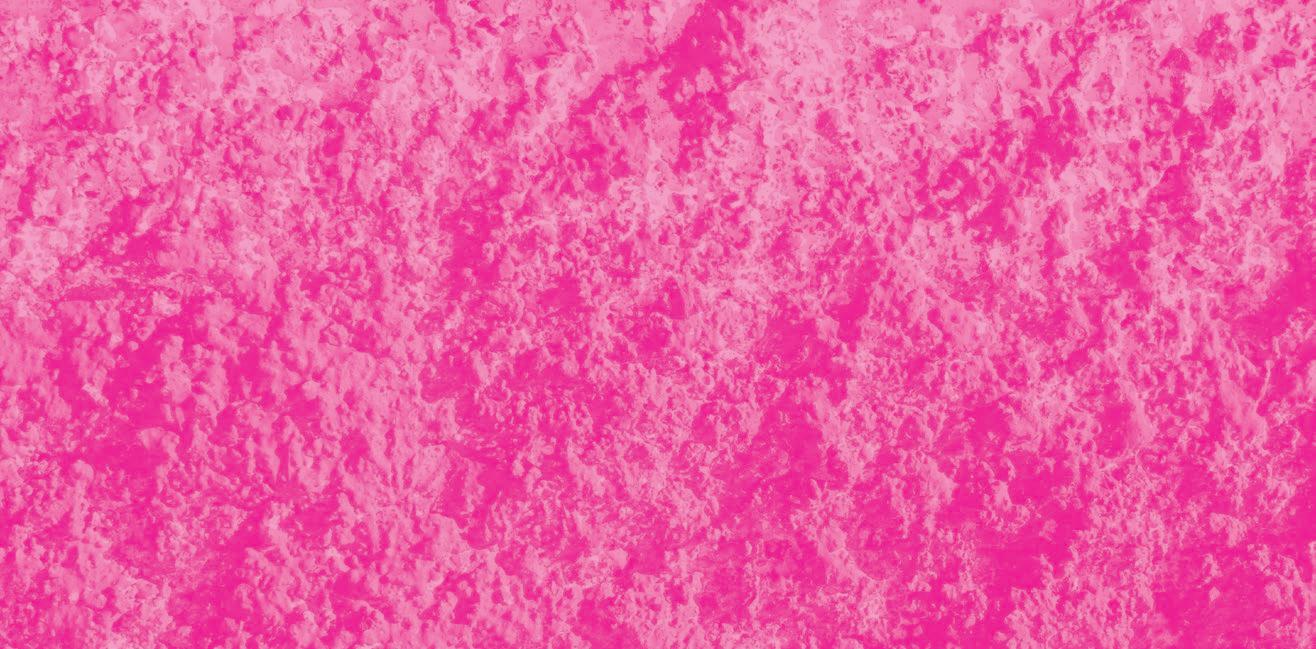
61597 29 Palms Hwy, Joshua Tree, CA 92252 IG @highdesertpride To submit, contact: cmdfenton@ gmail.com
Sun 6/9 @ 8:00-9:00 am
Hike with PRIDE, Led by Ranger Meg, Joshua Tree National Park
Hi-View Trail at Black Rock Nature Area (1.3 mi. Loop) 9800 Black Rock Canyon Road, Yucca Valley, CA 92284
Mon 6/17 @ 6:30 pm
Desert Bingo Presents: PRIDE BINGO! Donations go to the ACLU for LGBTQIA+ civil rights Red Dog Saloon 53539 Mane St, Pioneertown, CA 92268 IG @desertbingo
Fri 6/21 @ 2 - 10 pm
Summer Solstice Witches Party Milk Thistle Yucca Valley 56332 29 Palms Hwy, Yucca Valley, CA 92284 IG @milkthistleyuccavalley https:// milkthistleyuccavalley.com
Sat 6/22 @ 2 - 6pm
The Saloon’s Annual PATIO DANCE PARTY! Joshua Tree Saloon 61835 Twentynine Palms Highway, Joshua Tree, CA, 92252 IG @jt_saloon.
Sat 6/22 @ 6 pm
Jello Wrestling ! info@thetinypony in advance to sign up Tiny Pony
57205 29 Palms Hwy, Yucca Valley, CA 92284
IG @ the.tiny.pony https://www.thetinypony.com/
Sun 6/23 @ 12-5pm
Desert Split Open Mic
Beatnik Lounge
61597 29 Palms Hwy, Joshua Tree, CA. 92252
IG @desertsplitopen

Fri 6/28 @ 8 pm
HORSE GIRL, an absolutely OBSURD backyard drag extravaganza
Hosted by OBSIDIENNE OBSURD
Tiny Pony
57205 29 Palms Hwy, Yucca Valley, CA 92284
IG @ the.tiny.pony
IG @0b.world & @obworld.productions
Sat 6/29 @ 6 - 10 pm
Pride Ball hosted by Lady Chilane and Mr. Jeffro
“Infinite Love Photo Booth” by photographer Sandra Goodin
JT RV Campground
6225 Sunburst St., Joshua Tree, CA 92252
IG @beautybubblesalon @theladychilane
Sun 6/30 @ 4 - 8 p.m.
PRIDE Crafting! Mosaic Tiles & Indigo Dye, Spoken Word Open Mic
With Scorpion Lollipop at Courtyard 62
73552 29 Palms Hwy, Suite 1 • Twentynine Palms, CA 92277 @shopcorner62 @scorpionlollipop @outtherebar
Afterparty & Pride Stickers at OUT THERE BAR ! 8 pm - 2 am
73839 29 Palms Hwy, Twentynine Palms, CA 92277
22






Fridays: Grey Hill’s Open Mic Sign-ups at 6:30, show at 7. No cover.
Sat., June 1st: Alien Probe, Yvonne Champagne and Landroid Outdoor show. 7 pm, $10
Sat., June 8th: Jon Langford (of the Mekons!) and the Bright Shiners with special guest Sally Timms (also of the Mekons!!!) 7 pm, $20. Limited seating. Tickets on Eventbrite.
Fri, June 14th: Rock Me Like A Hericane. 6 pm, outdoor show
Sat., June 15th: Red Light Lit (Storytelling and music). 7 pm, outdoor show, $10
Sat., June 22nd: Record-release party for Paul Moeller 7 pm, outdoor stage, No cover
Sat., June 29th - Live music TBA






LIVE ENTERTAINMENT
Open Mic Night Every Sunday. Jasmine & Lorenzo Every Friday For event listings, visit: spaghettiwesternsaloon.com




GIANT ROCK MEETING ROOM














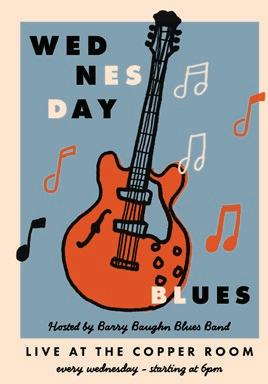






For all listings go to our calendar at. JoshuaTreeVoice.com 24 Open Mic is Sundays 1-5 PM on the outdoor patio. Sign up begins at noon. Hosted by Cris Aldrich of the Cris and the Gang band. (Moved from Tuesdays) THE COPPER ROOM LIVE JAZZ EVERY SUNDAY 6PM - 9PM LIVE BLUES EVERY WEDNESDAY - 6PM For event listing visit: theCopperRoom1957.com
For event listings, visit: giantrockmeetingroom.com For event listings visit reddogpioneertown.com SALOON 83131 Amboy Rd, Wonder
760-361-2810 palmsliveevents@gmail.com
Valley
events listing, visit: pappyandharriets.com
For

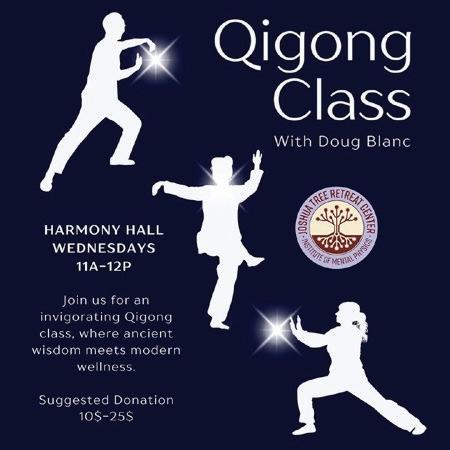


















25



Two Mekons, One New Band, and a Rare Desert Appearance
By Kevin Bone
Jon Langford..vocalists, guitarist and a founding member of the Mekons, is set to perform in town with his latest musical project, “Jon Langford and The Bright Shiners.” Adding to the bill will be musical cohort Sally Timms (also of Mekons’ fame), who will join Langford to perform some of their iconic songs acoustically.
The Curse Of The Mekons
Haven’t heard of the Mekons? Neither had I until a good friend insisted I join him for a show at The Knitting Factory in New York City’s East Village. Despite their talent, the Mekons struggled with recognition, partly because they defied easy categorization. Originating as a punk band from an art collective, they evolved into something unique—an amalgamation of rock and roll influences that defied simple labels. Their live shows were an eclectic mix of styles, featuring eight musicians with several taking turns as vocalists. At that time the Mekons had just released their eighth studio album, “Rock And Roll,” and they seemed to be finally start to gain some attention.
A New Fan
Not five minutes into this performance I was hooked. I had been a live music fanatic for over a decade, but by the end of this show in 1989 I had crowned The Mekons my new favorite live band. Their eclectic mix of rock and roll, coupled with smart and whimsical lyrics, gritty energy, and great hooks, set them apart. Not only that, the between-song banter between Jon Langford and Sally Timms was hysterical. My face hurt from laughing, my legs were sore the next day from dancing.
A Mekons’ Fan is a Dedicated Fan
After that, I went to see them every chance I had. I was not alone. Their live performances were magnetic, drawing fans who would drive hours to see them. Even though the band members were spread across the U.S. and the U.K., their sporadic tours were must-see events for their devoted followers.
Not Just a Mekon
Like others in the band, Langford and Timms have both engaged in multiple projects outside the Mekons. Sally Timms has a solo country western album and has collaborated with The Sadies. At 19, she worked with Pete Shelley of the Buzzcocks on an improvised film

score. Jon Langford is involved in numerous projects, including The Waco Brothers. His creative endeavors span music, theater, and painting… he recently showcased some of his artwork at a group show in Rancho Mirage.
A Special Performance in Wonder Valley
Lucky for us, Jon Langford is bringing his latest music project, “Jon Langford and the Bright Shiners,” to our neck of the desert, The Palms in Wonder Valley (15 minutes East of downtown Twentynine Palms). This acoustic four-piece band features Langford on vocals and guitar, Alice Spencer on vocals and Mellotron, Tamineh Gueramy on vocals and violin, and John Szymanski on guitar (Szymanski is also a member of the “Mini-Mekons,” an acoustic, abbreviated version of the Mekons featuring Langford and Timms that performed at The Palms last year). Sally Timms will also perform, reuniting with Langford for a set that promises to be as delightful as their storied past performances. Expect their signature banter, which alone is worth the price of admission.
Event Details
Catch Jon Langford and the Bright Shiners, with special guest Sally Timms, on Saturday, June 8th, at 7 pm, in the intimate back room at The Palms in Wonder Valley. Tickets are $22.50 and available through EventBrite. Seating is limited.
Venue: The Palms, 83131 Amboy Road, Twentynine Palms, 92277. Food and a full bar are available. For more information, call (310) 920-4804.
27
Photo by Richard Malpas
Photo courtesy of Hardly Strictly Bluegrass Festival
Photo by Richard Malpas


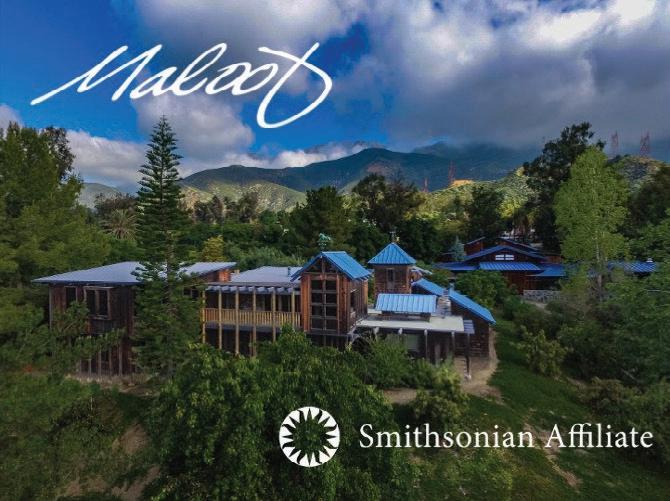
JOIN US AT THE MALOOF FOR A DESERT DESIGN GALLERY TALK + FILM SCREENING
DESIGNER/MAKER JOHN VUGRIN
A STUDENT OF JACK ROGERS HOPKINS SHARES HIS EXPERIENCES CREATING THE INTERIOR DESIGN OF THE DOOLITTLE HOUSE, ARCHITECT KEN KELLOGG’S JOSHUA TREE MASTERWORK
MODERATED BY ARCHITECTURAL HISTORIAN ALAN HESS SATURDAY, JUNE 15 3:00PM – 5:00PM
SPACE IS LIMITED. FOR RESERVATIONS: Melanie.swezey@malooffoundation.org
MALOOF FOUNDATION
5131 CARNELIAN STREET RANCHO CUCAMONGA MALOOFFOUNDATION.ORG 909-980-0412
JACK ROGERS HOPKINS
CALIFORNIA DESIGN MAVERICK EXHIBITION ALSO ON VIEW DURING THIS FREE PUBLIC EVENT.
8th Annual Labor Day Fireworks Show at Homestead Valley Park
By Tracey Rader
The 7th Annual Labor Day Fireworks Show at Homestead Valley Park in 2023 was a huge success with an impressive turnout of over 1000 people. The community enjoyed great food and craft vendors, face painting, a dunk tank, and the 2023 California Music Hall of Fame Inductees, The Mighty Cash Cats, who graced the stage with awesome music!
It is our pleasure to inform you that we will be repeating and improving upon our upcoming fireworks event for August 31, 2024. Music will be provided by South 40, an outstanding southern rock band out of Arizona. Our amazing vendors from 2023 will be back and we have a few new vendors as well. We are committed to delivering a memorable experience for all our attendees!
We rely on the community’s support to ensure the continuation of the Annual Labor Day Fireworks Show, bringing
joy to the faces of the children and community members.
Your participation is crucial in making this event a success. Thanks to everyone who has committed to sponsorship so far. Join us in supporting this cherished tradition and help create unforgettable memories for everyone. We hope that you will consider supporting this event and joining us in making a positive difference in our community and beyond. If you are interested in supporting, vending, or volunteering, please reach out to us by July 31st, 2024. We hope to see you there!


Contact Event Coordinator, Tracey Rader, at rader.tracey@yahoo.com regarding donations and event questions.
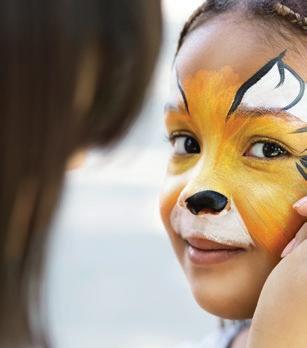


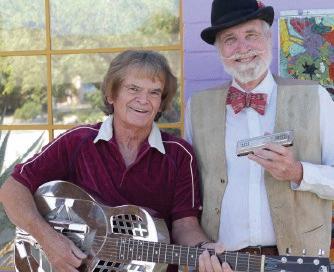
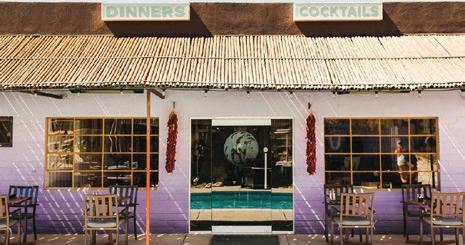


RESTAURANT IS OPEN! Live Music 5 Nights a Week Wednesday through Sunday Inn Between 2-4pm | Dinner 5-8pm 29palmsinn.com | 760.367.3505

MARY JEYS: SHAPE SHIFTER
“We have such a diversity of artists here, all dedicated to supporting one another and the work we can do together. I am often looking for ways and modes to introduce a sense of possibility through play and interaction.” – Artist, Mary Jeys
By Katie Nartonis
Mary Jeys’ art practice is constantly changing Her most recent works have involved watercolor, ceramics, and live video. She notes that the kind of work she does, “is very much invested in modes and meaning of exchange, value, play and interaction. I have many media I approach using this thinking strategy.” She relates to the Voice that, “Over decades really, the material exploration has never remained fixed. I am not an orthodox craft practitioner, but instead a hybrid form creator.
The artist has had many terms to describe what it is she does: performative installation art, social engagement practice, and most recently interdisciplinary arts. It’s one of the things that makes answering a question like
“what kind of art do you make?” so hard. It changes regularly. She can even become jealous of other artists who find whole worlds in one medium and who can invest in the tools and technology to support their focused explorations.
Since Jeys has moved to the Hi Desert, her “watercolors have jumped off the flat wall to become 3-dimensional physical puzzle pieces, my ceramics have become play tools.” She has also become a co-steward of the cabin shop at the Sky Village Swap Meet now called Sun Spot “I’m proud of the work I have created in the space of community, exchange and platforming including coordinating this year’s NEA Big Read.”
Born in Houston, the artist grew up outside of Boston –one of three daughters of a physicist and a lawyer. She describes her parents as smart and driven contributors to their given fields. Jeys notes, “There really wasn’t a time before I was an artist. Even when I thought I would become a professional figure skater, or a marine biologist, or a veterinarian (from when I was 12) everyone else could see that I was an artist.”
By the time she was an undergrad in Austin, TX at the University of Texas she had made a conscious choice to move towards art as a life pursuit. “I could see that it would be hard, but much more rewarding in becoming a full realization of myself.” When she
30
graduated, she took part in a work abroad program in Dublin and then eventually relocated to New York after 9/11. In New York, she resumed what she describes as “a kind of expanded sense of public engagement.” In 2008, she created a fictional election campaign for the hero of Die Hard - running attack ads against the villains. Later, she held the actual election with real ballots at Mana Gallery in Jersey City, NJ. Jeys notes, “I’m happy to tell you that John McClane (not McCain) won in a landslide!” Next, she embarked on a largescale work which was developed as a response to the 2008 financial crisis. She printed paper money and held events at her shared studio/gallery in Brooklyninviting people to trade goods and services using an alternate, local currency called The Brooklyn Torch.
When she moved to the Bay Area of California she did so with a lot of hope and confidence in her art practice and her effectiveness in eliciting audience engagement. Unfortunately, for the seven years she lived in the Bay Area, she felt that she had “run aground” – and was never able to fully gain the momentum and excitement and connection to her work that she had enjoyed when she was in New York. The High Desert has helped her rediscover that sense of community and pursue her essential creative journey.
Jeys had visited the Desert a couple times before she really felt the call for a change in 2021. During one visit (in the middle of the pandemic and her MFA studies) she met a group of artists (including Elena Yu) at the Swap Meet. It was in the cabin shop formerly known as High Desert Test Sites HQ where “there was simply an emotional connection to Elena and other artists in this community that I felt profoundly. I sensed in a few minutes that my heart and my work needed this change. So, towards the tail-end of the housing frenzy in 2021, we got a house here. “
She describes her studio space as holding a sacred archive of past work - documenting the many media and tools she has used in past projects. “I have knitting needles, a sewing machine, paper pulp, boxes of clay and glazes, video screens (and so many wires!), paints in various media: water, oil, acrylic,
a box of adhesives, tapes, wood boards, cameras, and of course pens and paper.”
Jeys has a strong sense of cultural context through which she views her work. She feels that she has lived thru enough contexts to see that there are recurring cultural cycles and waves that are worth remembering. “Many people in my generation mark their days from crisis to crisis. Much like our parents’ generation saw the political assassinations as a turning point, we have seen many turns: 9/11, Katrina, and now Covid-19. These have been extraordinary events that everyone in our culture has been affected by. It has been my position that we must find resiliency and hope for another future, and that artists have special skills in adaptation and creation that



are desperately needed but aren’t yet being supported in the way that would truly give everyone a sense of possibility. We need to do more than put band-aids on bleeding organs. Artists of any generation have the practice and resilience in following their own callings in spite of any challenge.”
Her vision for our desert community is generous. She hopes that artists “can continue to experiment wildly and with bravery - in the ever-shifting contexts of a culture that persists in denying artists their sacred role as teachers of potential futures. I hope that we can continue to support each other’s real potential in creation.”

Katie Nartonis is a writer, curator, film maker, and specialist in art and design. Her current exhibition (and documentary film) opened during 2024 Palm Springs Modernism Week: “Jack Rogers Hopkins: California Design Maverick” and is open through September 28th at the historic Sam Maloof Foundation. Look for her upcoming book, “Glimpses of the Joshua Tree Dream.”
31
One Woman’s Wild Love for Wildlife
By Jacque Guevara
Nicole Holland, owner of Cactus Mart, is a woman with a mission – and it’s a wild one.
Nicole Holland has been a desert girl since her early childhood. Her grandpa settled in Landers in the 60s in a tiny old home on 5 acres – a true homesteader. Nicole recalls her love of the desert starting then – taking showers outside with a hose, chasing jackrabbits around the property, and playing in abandoned old shacks. A vegetarian, Grandpa taught Nicole all about growing her own food - he was especially fond of his citrus trees – and taught her the meaning of community. Even in those early years, neighbors were important. Grandpa, Nicole, and crew would help neighbors out with their goats and chickens and accept payment in eggs!
Even after moving to the Coachella Valley as a teen, Nicole maintained her love of plants and “all things desert”. She began her career working for a landscape company and eventually partnered on a new business in Palm Desert called Lotus Gardens. As a small business, Lotus Gardens gave Nicole the chance to specialize in, and to work more with, drought tolerant and native plants. “Understanding the tie between flora and fauna began there, and it was eventually going to be a very important staple of my career,” she says.
In 2008, Holland decided to move “up the hill” to the Morongo Basin, appreciating the proximity to the “low” desert, the idea of living in her own little bubble, and having Big Morongo Canyon Preserve as a neighbor. She continued working in the low desert, but soon put down some deep roots in her new home. She remembers, “When I heard Cactus Mart was selling in 2012, I was immediately drawn to it. It’s all I could think about. Cactus Mart was a staple since the 1970s with its digyour-own cactus, fun unique gifts, and local art, like the fabulous wildlife photography of David McChesney.” It was a match made in heaven.

of wildlife – quite literally on a local level. She shares, “Bobcats have come into our store, deer come up our backstreet, and bears are right in front of our storefront in summer mornings.” Unbeknownst to most folks other than the locals, Big Morongo Canyon and the surrounding areas are home to annual bird migration and several wildlife corridors.
Separated by roads is right. In Morongo Valley, the proverbial river doesn’t run through it - Highway 62 does. As a matter of fact, Sand to Snow National Monument is neatly dissected by it. This presents a huge problem for wildlife crossing the highway in search of water and trying to get to Big Morongo Canyon Preserve and back again.
Over the years, Nicole has noticed an influx of people moving to the area, and an increased number of tourists, most of whom have no idea that they are moving through a wildlife corridor as they travel “up the hill” to hike and enjoy Joshua Tree National Park and other desert public lands. The numbers really increased during COVID, as getting away to the desert provided solace and release for thousands of city-dwellers prohibited from their usual recreational pursuits. Unfortunately, a lot of the time people speed up and down the highway through Morongo Valley without even realizing the negative impact they may have on the area they have come to enjoy.
As Nicole puts it, “Our wildlife is paying the price. Especially with last summer’s fires
What she quickly found out in her new business, was that Morongo Valley was also home to a wide variety
Wait, what’s a wildlife corridor? Oxford Languages Dictionary defines a wildlife corridor as “a strip of natural habitat connecting populations of wildlife otherwise separated by cultivated land, roads, etc.”

32
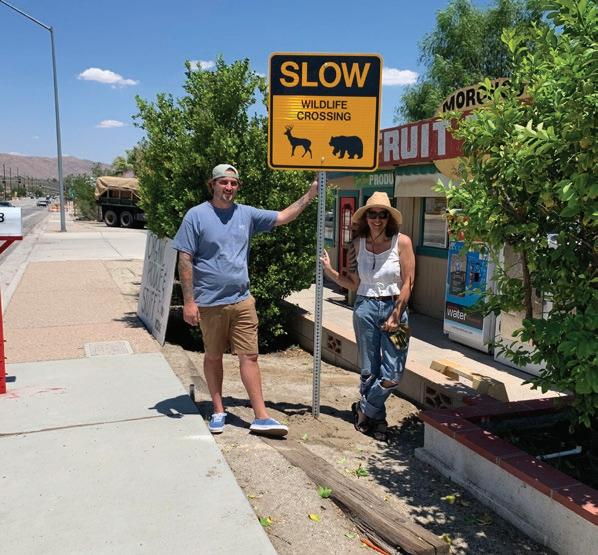
and the drought, bobcats, mountain lions, coyotes, bighorn, bears, and deer were all getting hit crossing over the highway.” According to her, a collective of locals started leaving out watering stations to try to mitigate the number of animals crossing the highway to get to the preserve, but it wasn’t enough. Sadly, many were struck and killed on Highway 62 during the summer of 2021. That’s when she and some of her friends got together to take it a step further.
They decided to pitch in and install wildlife crossing signs on their own properties to attempt to bring some awareness to the issue. And for a time, it worked. People seemed to slow down and become more aware of their driving and the wildlife. Questions flooded in on social media asking about wildlife and where people could get the signs for their own areas – even from as far east as Wonder Valley. Big Morongo Canyon Preserve got in on the action and are still working with Nicole and company to erect larger billboards on their property coming up the grade from the Coachella Valley.
Conservation legend and resident naturalist at the 29 Palms Inn, Pat Flanagan, shared that the attention being generated by Nicole and group is part of a larger and smaller – story. Much work has been done on studying and preserving wildlife corridors throughout the Mojave Desert and surrounding regions for decades, work Pat and others in the conservation community have been an integral part of completing. And though the big critters like the bears and deer are most definitely negatively impacted by the heavier traffic in the area, she cautions us not to forget about their smaller counterparts – the rabbits and other small rodents, the lizards and snakes, the birds, and even the insects. “There are certainly many daily deaths of the smaller desert creatures that go completely unnoticed.”
Though positive changes have been made on this local issue, there is more work to be done. Nicole plans to keep educating people about which wildlife is found in Morongo Valley. Others in the group have contacted Caltrans and advocated to reduce the speed limits through the main stretch in town. The process has been started to effect this change, and though the speed can only be lowered 5 miles per hour, Nicole says she is still happy with any progress that can be made in that area. “Hopefully if we just keep the awareness factor going and can lower the speed limit a little bit, people will slow down and realize what they are actually driving through is not some sleepy little town, it’s a wildlife corridor.”

Want to help? Here are some steps to follow –
1. Educate yourself about the wildlife corridors and wildlife in the Morongo Basin
2. Share this messaging with 5 friends, and ask them to share with 5 friends as well
3. Support Nicole and her neighbors in their work
4. SLOW DOWN while driving on Highway 62 (and all desert roads) and watch out for the wildlife!
To learn more about wildlife corridors in the Morongo Basin, follow this link to the Morongo Basin Conservation Priorities Report on the Morongo Basin Conservation Association website.
https://sonoraninstitute.org/files/pdf/morongo-basin-conservation-prioritiesreport-a-strategy-for-preserving-conservation-values-07112012.pdf
To learn more about Nicole Holland and her crew at Cactus Mart, follow this link to their website.
https://cactusmart.com/
33
Photo by Millicent Harvey
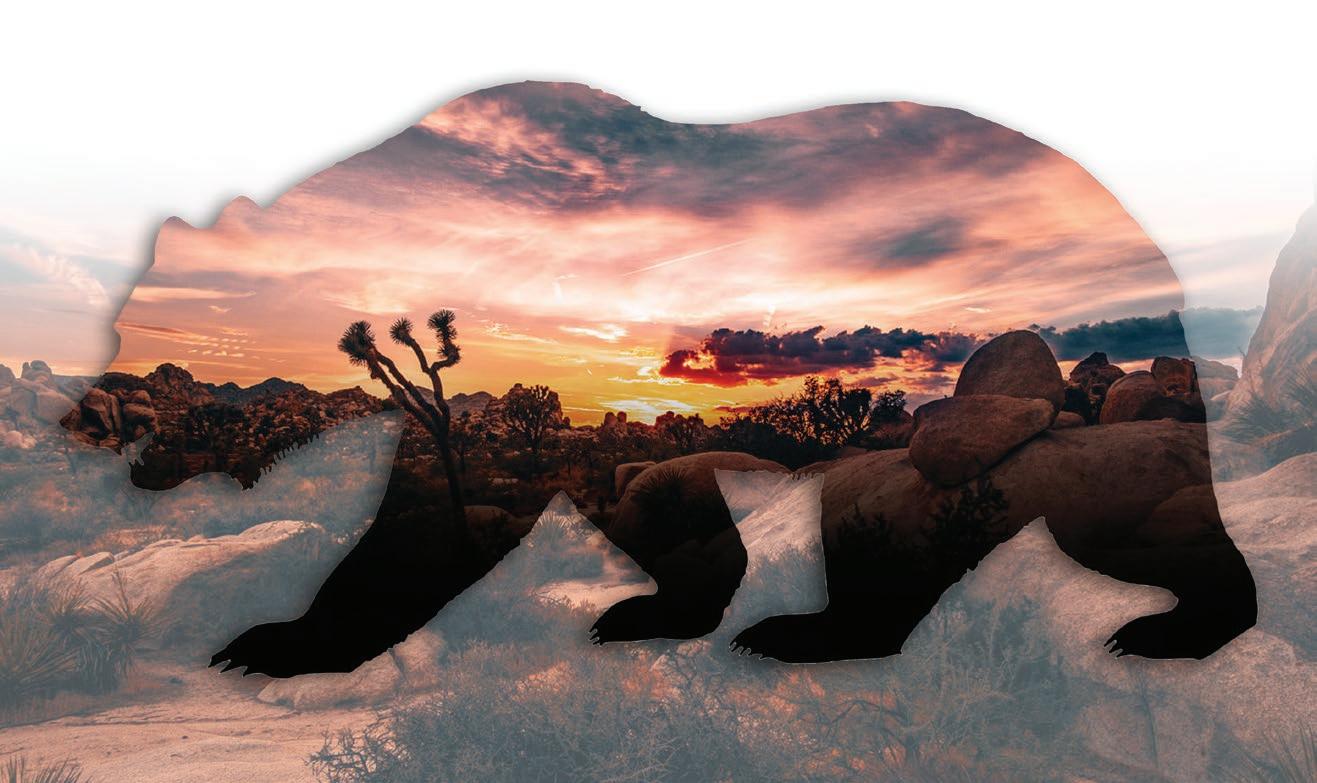 By Rex Edluhnd
By Rex Edluhnd
Don’t feed the bears, not even accidentally, which it turns out, many people in Pioneertown were doing by freely loading up bags and bags of uneaten food and unwanted leftovers and filling our trash bins. I added to the problem by keeping a bee colony that had made a base in an old whiskey barrel. All these things generated the gentle waft of dumpster smorgasbord and sweet honeycomb irresistible to a clever brown bear on a springtime excursion.
I am a resident of Pioneertown. This is my 3rd year being here full time, and I am still learning constantly about what it takes to exist in this still rather wild west. I am in the process of making adobe bricks for my home building project and much of the first 2 years was spent on getting the permitting department and inspectors to comprehend the ancient tradition of building with adobe. This will be the first fully permitted adobe home in San Bernadino County in about 30 years. The resistance was odd, I mean who wouldn’t want a fireproof, soundproof, earthen structure that is also, now importantly, bear proof. I set up in a camper, got all the permits for the temporary dwelling, rented a container for storage and have a lot on my plate for the build.
The last couple of years a black bear has sauntered into town, coming in at my corner of paradise, which
Don’t Feed the Bears…

is adjacent to the Pioneertown Preserve, a roaming area of hundreds of miles for wildlife as they are able to cruise around from Big Bear to here. It would raid the trash bins like the CIA looking for secret files and leave its distinct debris field. But it would be gone in a day or two, then life would resume. But this time was different. We have a Yogi-like professional on the scene.
I didn’t know, and there was no one around to tell me, that an outdoor cooking area is a no-no. I also had no idea that when I was adopted by the honeybees that I would need to supply them with an electric fence. Not just any electric fence, but one strong enough to deter a bear, not found at Tractor Supply! It needs to be above one Joule in power. The rest of the supplies can be found there, but you’ll need to order the power source online.
In mid-April I had a giant raid on my outdoor refrigerator and cooking area (that I no longer have) and the strategic heist of all the honeycomb. This massive mammal gave my homestead a five-star rating and even though everything is now stripped bare for the bear, she comes by almost every night to check. She can smell through the container, she knows her “stuff” is in there and is always trying the lock. Initially, I put a steel spike in the door latch, but after coming out and seeing it bent nearly in half, I upgraded to an oversized padlock. It would be in the container in a heartbeat without that lock.
I had a total of 3 raids. Once to the refrigerator. Then again before I had time to relocate the stuff, even though I had stacked a half dozen pallets in front of it. Those were tossed aside like a pillow even though there was little left to consume. The third night I was ready with pans to clang and was getting annoyed. The persistent bear showed up at 2AM. My dog Polly was going ballistic in the camper, but the big black bear did not seem to care. I hustled to the door and fought Polly to keep her in. I’m not willing to risk my girl getting swatted by a bear in the middle of the night. As I came out as cacophonous as possible, the culprit lumbered off into the night, right past me. Bleary eyed and only recently shocked awake, I was kind of confused as to what I saw. The bear stole my microwave - ran off with it by the cord! It must smell like food. As I looked at the wreckage and was getting ready to try bed again,
34
I saw that the bear had come back and was cautiously easing towards me, only about ten feet away. I was pretty spooked, but the reissuance of clanging pans and a shocked expletive got it to run off. Geez. But now, I am getting used to it and have even started referring to her (I am guessing it’s a her) as Brenda.
The next morning, I discovered she had also climbed up a rickety ladder, leaned against my big metal shipping container, and readdressed the beehive remains that I had placed up there. I had hoped it was a safe place for the hive to regroup. I even purchased a legit hive setup and took slices of honeycomb that I placed between the frames to give it a new start. There was also a big plastic container with the combs I had salvaged with about 8 gallons of honeycomb there for the bees to work with. At least, there “was”.
Brenda climbed the ladder. It was weird to see that she not only got up there but didn’t destroy a bit of the hive. She moved the top off and carefully lifted out the honeycomb from between frames just like you would if you were pulling a document from a filing cabinet. She stripped it completely and ate every speck of honeycomb from the bin - licked it clean. The plastic wasn’t even sticky. I still have a hive but will refrain from beekeeping until I am no longer considered a 5-star bear restaurant. When I do the bee thing again, it will have an electric fence.
Which leads me to what one CAN do about bears.
Since dozens of locals flooded the Department of Fish and Wildlife, as well as the rangers in the Pioneertown Preserve, with alarmed phone calls, we were graced with a presentation of Living with Bears by the Rangers who held a bear-centric community meeting at the Pioneertown Fire Station.
Relocation is not an option. It usually serves as a death sentence for the bear, and even sanctuaries are the equivalent to jail. Plus, I spent some time discussing options with sanctuaries. The expense is pretty significant. Just to build the enclosure to contain these demolition experts would cost around 60K.
It appears there is nothing much that can be done other than making it barren for the bear. We need to focus on removing all food sources. This includes dog food, chicken feed, horse treats, bird seed, and certainly no outdoor refrigerators. Only a fool would have something like that.
If you have fruit trees, harvest them as soon as the fruit is ripe. Fruit fermenting on the ground is a big-time bear attractor.
Bee hives and chicken coops are going to need an electric fence. I did not know that, and now what WAS a beehive is just a couple scraps of wax I salvaged. (You can see the devastation from Brenda eating a barrel of honey at my Instagram @wildmojaveranch)
I asked if it is a bad idea to even have a beehive. The ranger informed me that with the electric fence, it is such a deterrent, it effectively counteracts whatever attraction the smell creates. Incidentally, a bear will know what you have. According to the National Institute of Environmental Health Sciences, a bear’s


sense of smell is 7 times better than a Bloodhound’s or 2,100 times better than a human’s. Lock things up tight. It can’t be hidden.
Try not to have any tasty bits like apples or other fruit in your composting. Bears are omnivores that eat a primarily vegetarian diet. But keep that “omni” part on your mind. Though they would love a bowl of apples, they may also eat your face. No touching.
Keep your food waste inside a locked area or in your refrigerator until the morning of trash pickup. We should be able to communicate this effectively to our residents, but Pioneertown is almost half Airbnbs, and visitors leave tons of food behind. Getting the operators of those establishments as well as their cleaning crews onboard to deter bears will be a bigger challenge. Most often there is no one to actually talk to. It will have to be an ongoing effort.
Another challenge is the dumpsters. They have plastic lids that the bear can bypass in a second even if locked. The contract for trash removal from our tiny mountainadjacent town is Burrtec Waste. Though many Pioneertown residents have requested bearproof receptacles, with metal lids, it is not something they currently have in inventory - something to consider the next time that contract is granted. We need tougher receptacles.
This isn’t just a town problem. Unless we take real action, it will become a bigger one.
A local caterer and chef in the Rimrock area had a vintage trailer turned into a commercial kitchen. Brenda cavalierly tossed the door aside to rummage around and rid the space of all baking ingredients.
It’s a shame there was no security footage. As the bear hoovered up all the flour and powdered sugar, we could have gotten a LOT of great “Cocaine Bear” memes out of that event. I have another neighbor that lost a shed door because there were some horse treats inside. Brenda has a mean sweet tooth.
On the evening of our Living With Bears talk, the ranger told stories of incidences such as a bear busting a shower window to get a bottle of mango conditioner. The smell was just too tempting. He also shared a photo of a sweet, little old lady illegally feeding a black bear. She was known to do this regularly until, one day, a bear was curious about just how sweet she was and devoured her.
Again, NO FEEDING and NO TOUCHING!
The takeaways from our Living With Bears meeting was… live with bears. Remove any and all food sources. Get yourself a can of bear strength pepper spray, an air horn, and maybe even a paintball gun to make the area unfriendly, and they will eventually move on.
It’s been a month, and as of just last night, Brenda roams the dirt roads of Pioneertown all night, infuriating the dogs, and making a good night’s sleep a thing of the past. She comes by, tests the lock on my container and moves along. But she does this 2 or 3 times a night, even though I have completely removed all potential treats. It must have been really, really good honey. I hope to find out someday.
Picture courtesy of Sheree Sorens: Brenda possibly thinking about stealing neighbor’s vehicle to go for a joyride or maybe a cross-country picnic basket robbery spree.
35

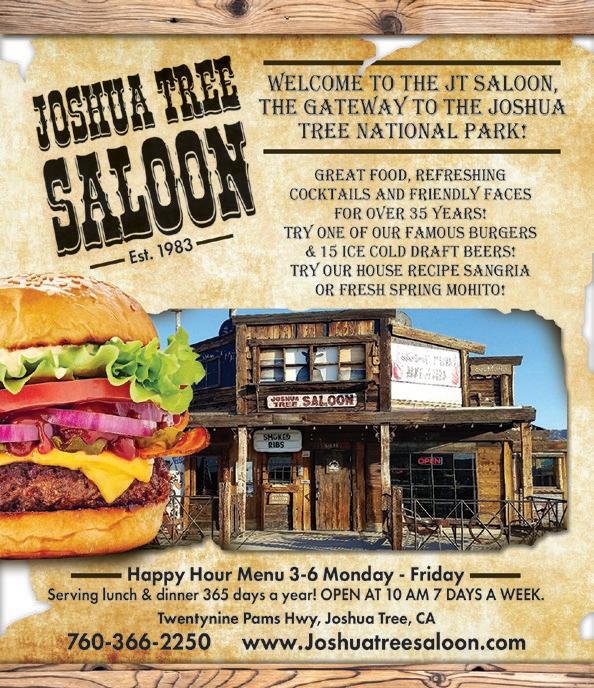

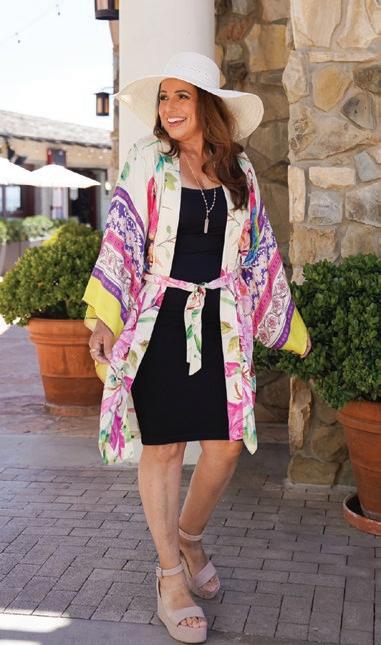
HI-DESERT TAILS PET FOOD AND SUPPLIES YUCCA VAL L E Y , C ALIFORNIA SPECIALTY Pet food & Supply store in yucca valley OPEN EVERYDAY 10am-6pm FREE Chicken Neck Dog Treat if you mention this ad! 57560 29 Palms Hwy, Yucca Valley, CA 92284 760-820-1133 Natural Foods, Treats, Toys & Accessories JW Marriot Shopping Colonnade 74855 Country Club Dr Palm Desert 92260 Ph: 760 846 8757 Desert Springs Marketplace 74924 Country Club Dr Suite G-130 Palm Desert 92260 Ph: 760 895 4132 El Paseo 73255 El Paseo, Suite 21 Palm Desert 92260 Ph: 760 334 1638 “Last Chance” OUTLET on El Paseo 73896 El Paseo, Suite R-13 Palm Desert 92260 Ph: 760 492 0635 Palm Desert La Quinta Old Town La Quinta • 78065 Main St, Suite 102 • La Quinta 92253 • Ph: 760 219 7165 Coco Rose Home • 78010 Main St, Suite 100 • La Quinta 92263 • Ph: 760 219 7165

Rose M. Villiers, age 7
I like to clappity clap and I like to snappity snap and I like to jiggle my hips
And it goes like this
Clappity clap, snap snap snap snap
Move your hips now
Clappity clap, snap snap snap snap
Clappity clap, snap snap snap snap
Do it like this now
Clappity clap, snap snap snap snap

EDITOR’S NOTE:
Dearest Poetry Corner Readers, As we go into our summer break, I’d like to thank every one of you for your support of The Poetry Corner. Your readership is the pillar of print. The high desert continues to be an everflowing arts community that inspires all who interact with it. The origin story of The Poetry Corner itself begins with an open mic holding space for such art. May these local children and budding artists serve as a reminder that although we can sometimes feel lost— through art, shall we always find our way. May the summer heat bring you into loving communion with water and may you find rest where you need it.
With love and gratitude, Angelus
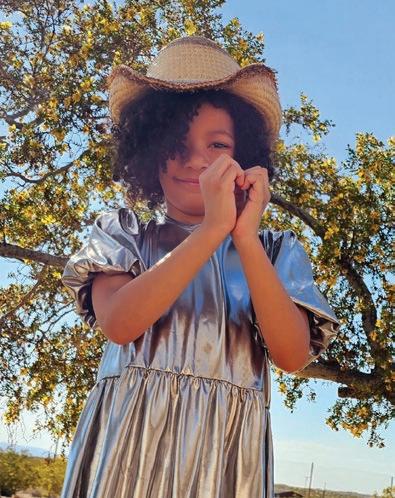
Marilyn Mays, age 8
The forest
I like to be in the lush, green forest, with beautiful birds singing and rivers murmuring. Bright green moss under my feet and the sunlight filtering through the trees making them glow. Vibrant yellow butterflies with their wings shining. Green everywhere I look, and a cool breeze drifting through the leaves making them dance and wave.
Background photo by Matthew Hall


This is The Marine Corps Air Ground Combat Center
U.S. Marine Corps story by Cpl. Hunter Wagner and Lance Cpl. Anna Higman
It was the 1950s. Tensions were rising overseas and the U.S. Marine Corps base at Camp Pendleton, California, was running out of room to provide the necessary training to be mission ready. The Marine Corps began looking for other locations to conduct training and exercises on a large scale, to accommodate live-fire training with artillery and rockets. A dormant training area 130 miles inland, previously used by the U.S. Navy and U.S. Army Air Corps, was selected to be used for a new Marine Corps Installation, then known as Camp Detachment Marine Corps Training Center, Twentynine Palms.
“Marines Arrive”, announced The Desert Trail to the local community on August 21, 1952, the day after the Camp Detachment Marine Corps Training Center was established in Twentynine Palms. The 200 Marines that arrived on that hot August day were warmly welcomed by the community.
“The local desert community was no stranger to military operations. Many local residents were World War I veterans who moved to the desert hoping the clean dry air would ease their suffering from mustardgas injuries” said Erin Adams, director of Government and External Affairs at The Combat Center.
The Marines were here to stay. In 1979, Camp Detachment Marine Corps Training Center was redesignated as the Marine Corps Air Ground Combat Center. That same year, the 27th Commandant of the Marine Corps, General Robert H. Barrow, personally tasked Col. Gerald H. Turley with building a live-fire combined arms exercise at The Combat Center. As the first director, Turley created the Tactical Exercise Evaluation and Control Group, which later became the Tactical Training and Exercise Control Group (TTECG) in 1995.
Throughout TTECG’s history, they have supported the Fleet Marine Force through Palm Tree Exercises, Combined Arms Exercises, Revised Combined Arms Exercises, Mojave Vipers, and now the Marine Corps’ premier Integrated Training Exercise. ITX, along with other new and improved exercises, was later incorporated into the Service Level Training Exercise Program (SLTE-P).
Due to its size and remote location, The Combat Center has been able to evolve in response to the known and anticipated changes in the operating environment and accommodate advancing weapon systems. During the Global War on Terror, the training focus shifted toward urban warfare. In recent years, The Combat Center continued to enhance its training capabilities in response to current pacing threats in the Indo-Pacific region.
38
Nearly every day of the year, there is training taking place. The Combat Center conducts several 60-day Service Level Training Exercises each year. These exercises are comprised of six training events, including ITX. They are designed to provide realistic and challenging scenarios to prepare deploying units to respond to crises and conflicts around the globe. Marines train in traditional combined-arms exercises and then participate in a culminating force-on-force exercise designed to challenge commanders while they operate against a tailored peer adversary. Service Level Training Exercises push commanders to be innovative and adaptive to better face our Nation’s ever evolving adversaries.
“The Combat Center enhances the Fleet Marine Force’s lethality by serving as the crossroads for the Corps’ Force Design and Force Development. The Service’s modernization plan is rapidly unfolding in many ways across multiple echelons of command around the world,” said U.S. Marine Corps Maj. Gen. Thomas B. Savage, Commanding General of Marine Air Ground Task Force Training Command, MCAGCC.
In December 2013, the National Defense Authorization Act (NDAA) authorized withdraw and reservation of public land adjacent to The Combat Center to provide enough land and airspace that could support large-scale, sustained, combined-arms, live-fire and maneuver training. The Combat Center is now the largest installation in the Marine Corps, with a landmass that spans approximately 1,190 square miles. The installation contains 27 training areas and 45 ranges. As result of the expansion, The Combat Center is the only military installation in the nation with sufficient training range areas to conduct large-scale MAGTF training, an enduring Marine Corps readiness requirement necessary to meet the demands of modern warfare.
Today, up to 45,000 Marines, as well as other U.S. and allied forces, train at The Combat Center every year.
“The permissive training environment at The Combat Center allows the MAGTF to employ new systems and concepts as they are designed in offensive and defensive operations as a regimental or brigade task

force, demonstrating a lethal capability in a combat environment,” mentioned Savage.
The employment of surface, air, and multi-domain fires cannot be replicated outside of The Combat Center. When you hear the sound of training, you are hearing our Marines preparing for deployment.
Situated in the Hi-Desert of California, The Combat Center is committed to being good stewards of our environment.
In 2004, the Tortoise Research and Captive Rearing Site (TRACRS) was established. TRACRS provides a controlled environment for the head starting of juvenile desert tortoises, to eventually release the tortoises back into the wild when they are larger and more resistant to predators. The installation has also implemented measures to protect tortoise habitats, conducted surveys and monitoring programs, participated in research studies, and conducted education and outreach programs to raise awareness about the importance of desert tortoise conservation.

Throughout the years, infrastructure improvements and expansion of housing facilities were made to provide better living conditions for personnel stationed at the installation. With improvements, The Combat Center achieved net-zero energy consumption and focused

on improving the quality of life for service members and their families.
As the U.S. Marine Corps’ premier training venue, The Combat Center continues to adapt to meet the ever-evolving changes and needs of our Nation and remains a vital asset in preparing Marines for combat by ensuring their readiness for future challenges.
Released by Capt. Johnathon Huizar, Director, Communication Strategy and Operations Marine Air-Ground Task Force Training Command Marine Corps Air-Ground Combat Center Twentynine Palms, California 92277 johnathon.huizar@usmc.mil
All photos Courtesy of Marine Corps Air-Ground Combat Center
39


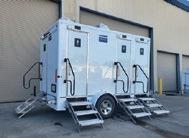

















OUR SERVICE SETS THE 4 Stall 4 Sink Solar Suite STANDARD 7 Stall 2 Sink Suite Trailer Premier Plus Double Alcohol Sanitizer Stand 2 Basin Hand Wash Sink 10 Sink Trailer TO29ANDBEYOND.COM B KASHER LIVE MUSIC GUESTS FROM... SKYWATCHER GUIDED STARGAZING 71845 29 Palms Hwy June 7-8


Featuring new and
Specializing in St John, Escada, Chanel & Jamie Sadock

Copper Mountain College Call for Community Education Teachers
By Jeremy Quinones-Licea

Attention desert folk. Do you have any expertise you would like to pass on or any skill you would like to teach? Copper Mountain College’s Community Education program is on the lookout for teachers of all sorts.


If you have a passion, talent, or skill you would like to share with the community, CMC would like to invite you to join us to teach a Community Education class this fall. The community’s college is encouraging people who want to teach others to apply to lead one or more Community Education courses. You can set the pricing and scheduling for the courses you teach.
CMC knows we have a talented community, and the Community Education program provides a great way to share those talents. Yoga? Art? Music? History? Writing? Surprise us – and the community! There are so many skills a person could learn, so buckle up and show us what you’ve got to share. CMC is here to connect you with students who would love to learn something new from you. Share whatever your heart desires. This is an opportunity to teach something useful, fun, or unusual, to people who are willing to learn.
Remember the deadline to apply to teach a Community Education course at CMC is the end of July. For full information, and to apply, see www. cmccd.edu/academics/communityeducation.

PHOTOS:
Top photo: Steve Brown, desert journalist and historian (pictured center) will be presenting desert history and culture this fall through CMC’s Community Education program.
Bottom photo: Mariana Wright will be teaching a writing course for the program this fall. There will be a dance class, CPR class, and many more course offerings this fall.

J PLEASE CALL BEFORE BRINGING IN YOUR ITEMS! 760-773-1988 REPEAT BOUTIQUE
gently used upscale women’s designer clothes, shoes, handbags, jewelry and more!
7 3 - 9 0 0 E l Pa s e o, re a r, # 3 , Pa l m D e s e r t We’re in the block between San Luis Rey and Portola, facing the rear parking lot, several stores east of Bank of America O p e n Tu e s d ay t h ro u g h S at u rd ay, 1 1 a . m . to 3 : 3 0 p. m . Closed for summer vacation July 26 reopening October 1 32 YEARS ON EL PASEO margasrepeatboutique.com SALE! 41




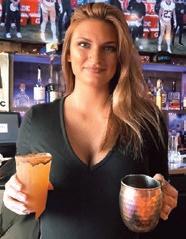




With 11 big-screen TVs, your favorite sport will be on. FansBarAndGrill.com • 4966 Adobe Rd, Twentynine Palms, CA Craft burgers, sandwiches, wings, and more. 50+ different bottled beers, specialty cocktails, & wine. 2001 Rexhall Class A Motorhome $23,500 OBO 31 ft. Runs great. 107K miles. Ford V10 engine. Hydraullic levelling jacks, onboard generator, queen bed, corner shower, 3 way fridge, propane heat, stove/oven, 2 roof a/c’s, 2 tvs & dvd players, reclining couch. This RV has made many cross country trips w/o any major problems. It has not been just sitting. Located in Yucca Valley. Known issues: living room floor laminate needs to be redone (peeling), chipped windshield, awnings damaged. Call (443) 904-2461 after 1pm FOR SALE


Auregan, the French Country Music Artist From Joshua Tree
This is the story of a French woman who fell in love with the desert and moved her entire life here. It is also the story of a woman who, even though she’s from the other side of the world where the genre doesn’t exist, writes, and performs country music.
That woman is Auregan, and she calls Joshua Tree home.
Flashback to 2017: Auregan lands at LAX. With her Visa in her pocket, she realizes she is not a tourist anymore, she’s moving to the US for good. She’s got no bank account, no cellphone, nothing but a single suitcase in hand.
Fast-forward to 2018: Auregan follows her heart and decides to escape the rat race and move to Yucca Valley. She is now a Hi-Desert full time resident.
In her newfound home, she starts exploring. First the neighboring states, then further, each time coming back home with her ukulele case full of song ideas, words, and melodies. Through the years, she has traveled the back roads of many states, from Arizona to Montana, Texas to Utah, New Mexico to Tennessee. She was on a mission to
discover American culture and in doing so, she learned how to speak English.
Now in 2024, Auregan recently released her first two country singles “This Freedom” on May 2, and “French Kiss a Cowboy” on May 23. The first song is a love letter to the desert and the bliss she found in her new life and country. The second song is a testament to her playful nature, with a country-pop anthem that you can’t help but sing, stomp along to, or even line-dance to!
The great outdoors is a daily source of inspiration for Auregan, and it shows in all of her creative endeavors. The official video for the song, “This Freedom”, that she directed herself, was mostly filmed in the Morongo Basin.
“The dirt roads and trails you see in the video are in Yucca Valley and Joshua Tree. We also filmed sequences at the dry lake in 29 Palms. There are clips from Oklahoma, Montana, Tennessee, Utah… But it was important to me to showcase our area as it brings me so much joy and inspiration. And the bike comes from Tractor Supply, Yucca Valley!”, says Auregan.
“This Freedom” sits in the broader country music genre and is a ready-todrive song that will no doubt be the soundtrack of your next road trip.
But it is her most recent release “French Kiss a Cowboy” that is making waves. The title is indicative of the mood and spirit: the song is meant to be a fun ride, and the quality of the sound and production are outstanding.
Auregan comments, “I wrote the song with Jeff Coplan, who is a Platinum and Gold certified producer, and CCMA nominee. He has worked in New York, Canada, and now has a studio in Nashville. He produced and mixed the song, and it was mastered by 6x Grammy winner, Ted Jensen, at Sterling Sound.”
“French Kiss a Cowboy’’ plays on Auregan’s French origins throughout, resulting in an infectious country music staple - the party song.
If “This Freedom” establishes Auregan’s journey and her love of the United States, then “French Kiss a Cowboy’’ shows her creative range and showcases her dynamic voice and entertainer persona.
“The desert is the home I never expected to find,” says Auregan. “I am aware of how lucky I am to live in such a place. I feel free, I am artistically inspired by everything I see, and I am constantly amazed by the beauty of it all.”



43






73501 Twentynine Palms Highway, Suite A, Twentynine Palms, CA 92277 • 760.865.0737 • Thaicafeusa.com We have prepared and served nutritious and original Thai cuisine for over 20 years in California. All of our food is created from original recipes and made from the finest and freshest ingredients to be found. Two locations: Yucca Valley / Twentynine Palms 57069 29 Palms Hwy, Yucca Valley, CA 92284 • 760.369.9566 • Thaicafeyuccavalley.com Find Your Dream Home On Our Website: https://www.glenrealty.com Email Us And let us Know What You Are Looking For. RUSSELL GIBBS Managing Broker, REALTOR® DRE #01127608 Cell (760) 668-6913
The 29 Palms Band of Mission Indians and Tortoise Rock Casino are hosting the 4th Annual Fourth of July Celebration. The celebration kicks off July 4th at 6 p.m. on the grounds of Tortoise Rock Casino. Enjoy a variety of food truck vendors, games for the family, prizes and giveaways, plus live music… and a spectacular display of fireworks set to music begins at 9 p.m. in honor America’s Independence.

Fourth of July Celebration














*3rd SaturdayS yUCCA vALLEY Art Walk 2024 Saturday July 20th Follow us: @yUCCAArtWalkassociation #yuccavalleyartwalk TRUCKIN SPACE JTNP Association 55922 29 Palms Hwy Open Vault Studios 55818 29 Palms Hwy Star Tile 55985 29 Palms Hwy Goat Mountain Co. 55940 29 Palms Hwy #7 Chaparral Artists at Rainbow Stew 55509 29 Palms Hwy Desert Curios 55995 29 Palms Hwy 5-9PM Compound 55379 29 Palms Hwy 12-5pm All Roads 55879 29 Palms Hwy 4-7pm 5-9PM 5-9PM 11am-6PM Remainders 55940 29 Palms Hwy #5 12-8PM 5-9PM 10am-5pm MazAmar Art Pottery 53626 Mane St. (Pioneertown) 12-7pm Mojave Light Studio 8444 Bannock Trail 1-5pm Space Truckin 55940 29 Palms Hwy #2 6-9PM Milk Thistle 56332 29 Palms Hwy 6-9:30PM Hi-Desert Artists 55635 29 Palms Hwy 5-9pm 3.5 Miles 2 Miles (use address) Desert Curios Milk Thistle Star Tile Rainbow Stew Kickapoo Tr. Church St. All DesertRoads Market Mazamar Art Pottery Mojave Light Studio Hi-Desert Artists Compound OpenVault Studios N 29 Palms Hwy Bannock Tr. Cherokee Tr. Pioneertown Rd. Geronimo Tr. Inca Tr. JTNPAssociation SpaceRemaindersTruckin Goat Mountain Co. Old Town Yucca Pioneertown
REVOCABLE LIVING TRUSTS*
*Created








GATOS TRAIL RECORDING STUDIO Clients Include: SHARON VAN ETTEN • SZA • MASTERS OF REALITY • YOUNG THE GIANT WWW.GATOSTRAIL.COM JOSHUA TREE CALIFORNIA
by an elder-law attorney with over 30 years experience Do your assets exceed $150K including the market value of your house? You need a LIVING TRUST. Without one, your estate will most likely go to probate costing a minimum of 3% of your total estate & all decisions will be made by the court, NOT you! Probate can take 6 to 30 months, and usually paid prior to access Call 800-767-7486 or email: PofMRP@gmail.com Visit PEACEofMINDRetirementPlanning.com FOR EXAMPLE Probate My Trust Cost Savings $250K would cost $7,500 $1,795 $5,705 $500K would cost $15,000 $1,795 $13,205 $900K would cost $27,000 $1,795 $25,205







































































































































 By Rex Edluhnd
By Rex Edluhnd




















































































